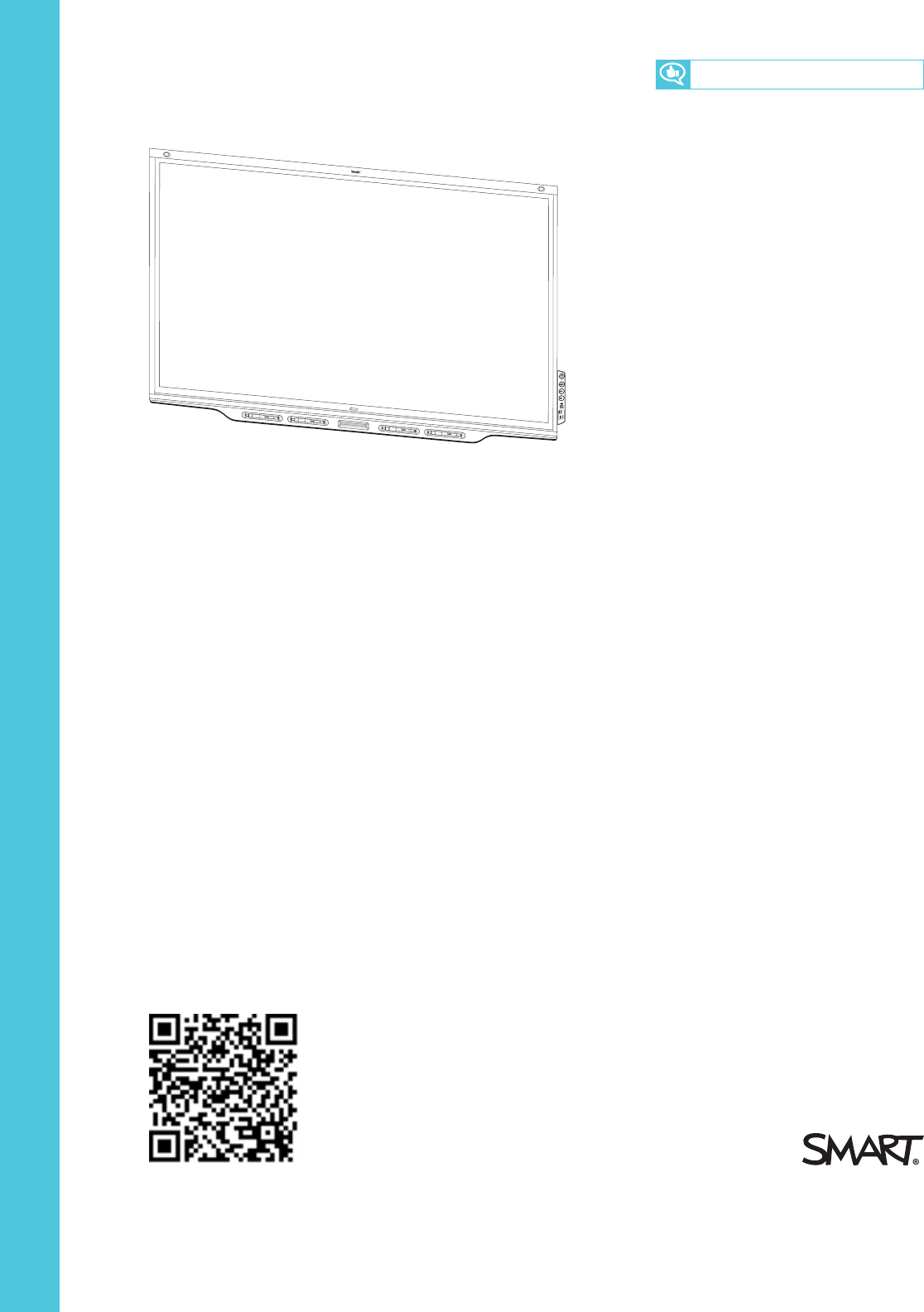SMART Technologies 7PEN Interactive Pen User Manual
SMART Technologies Inc. Interactive Pen
user manual
smarttech.com/kb/171164
Licenses
The terms HDMI and HDMI High-Definition Multimedia Interface, and the HDMI logo are trademarks or registered trademarks of HDMI Licensing LLC in the United
States and other countries.
The Bluetooth word mark is owned by the Bluetooth SIG, Inc. and any use of such marks by SMARTTechnologiesULC is under license.
Trademark notice
SMARTBoard, SMARTNotebook, SMARTInk, SMARTkapp, SMARTkappiQ, HyPrTouch, PenID, smarttech, the SMART logo and all SMART taglines are
trademarks or registered trademarks of SMARTTechnologiesULC in the U.S. and/or other countries. Microsoft and Windows are either registered trademarks or
trademarks of Microsoft Corporation in the United States and/or other countries. Apple, Mac, macOS OSX, iPhone, iPad, iPod touch, iTunes, AirPlay and Bonjour
are trademarks of Apple Inc., registered in the U.S. and other countries. Google, Google Cast, Google Play, Android, Chrome, Chromebook and Chromecast are
trademarks of Google Inc. AirParrot is a trademark of Squirrels LLC registered in the United States and other countries. All other third-party product and company
names may be trademarks of their respective owners.
Copyright notice
© 2017SMARTTechnologiesULC. All rights reserved. No part of this publication may be reproduced, transmitted, transcribed, stored in a retrieval system or
translated into any language in any form by any means without the prior written consent of SMARTTechnologiesULC. Information in this manual is subject to change
without notice and does not represent a commitment on the part of SMART.
This product and/or use thereof is covered by one or more of the following U.S. patents:
www.smarttech.com/patents
05/2017

i smarttech.com/kb/171164
Important information
WARNING
lFailure to follow the installation instructions shipped with the display could result in injury
and product damage which may not be covered by the warranty.
lDo not open or disassemble the display. You risk electrical shock from the high voltage
inside the casing. Opening the casing also voids the warranty.
lDo not stand (or allow children to stand) on a chair to touch the surface of the display. Rather,
mount the product at the appropriate height.
lTo reduce the risk of fire or electric shock, do not expose the display to rain or moisture.
lIf the display requires replacement parts, make sure the service technician uses
replacement parts specified by SMARTTechnologies or parts with the same characteristics
as the original.
lEnsure that any cables that cross the floor to the display are properly bundled and marked
to avoid a trip hazard.
lDo not insert objects inside the cabinet ventilation holes, because they could touch
dangerous voltage points and cause electric shock, fire or product damage which may not
be covered by the warranty.
lDo not place heavy objects on the power cable. Damage to the cable could cause shock,
fire or product damage which may not be covered by the warranty.
lUseonly extension cords and outlets that can fully accommodate the display’s polarized
plug.
lUse the power cable provided with the display. If a power cable is not supplied, contact
your supplier. Use only power cables that match the AC voltage of the power outlet and that
comply with your country’s safety standards.
lIf the glass is broken, do not touch the liquid crystal. To prevent injury, handle glass
fragments with care when disposing of them.
lDo not move or mount the display by connecting rope or wire to its handles. The display is
heavy, and failure of the rope, wire or handle could lead to injury.
lUse only VESA®-approved mounting hardware.

IMPORTANT INFORMATION
ii smarttech.com/kb/171164
lDisconnect all of the display’s power cables from the wall outlet and seek assistance from
qualified service personnel if any of the following occur:
oThe power cable or plug is damaged
oLiquid is spilled into the display
oObjects fall into the display
oThe display is dropped
oStructural damage, such as cracking, occurs
oThe display behaves unexpectedly when you follow operating instructions
CAUTION
lBefore you clean the display’s screen, freeze the screen. Otherwise, you may scramble the
desktop icons or inadvertently activate applications when you wipe the screen.
lAvoid setting up and using the display in an area with excessive levels of dust, humidity and
smoke.
lMake sure an electrical socket is near the display and remains easily accessible during use.
lThe display should be used only with European TN and TT power distribution systems.
It is not suitable for older, IT-type power distribution systems found in some European
countries. “This system (IT-type) is widely used isolated from earth, in some installations in
France, with impedance to earth, at 230/400V, and in Norway, with voltage limiter, neutral
not distributed, at 230V line-to-line.”
Contact qualified personnel if you’re uncertain of the type of power system available where
you’re installing the display.
lThe accessory slot’s maximum available power is 60 W. The slot is not a limited power
source. To reduce the risk of fire, make sure that accessories connecting to the slot satisfy
the fire enclosure requirements of IEC60950-1.
lYou must connect the USB cable that came with the display to a computer that has a USB
compliant interface and that bears the USB logo. In addition, the USB source computer must
be compliant with CSA/UL/EN 60950 and bear the CE mark and CSA and/or UL Mark(s) for
CSA/UL 60950. This is for operating safety and to avoid damage to the display.
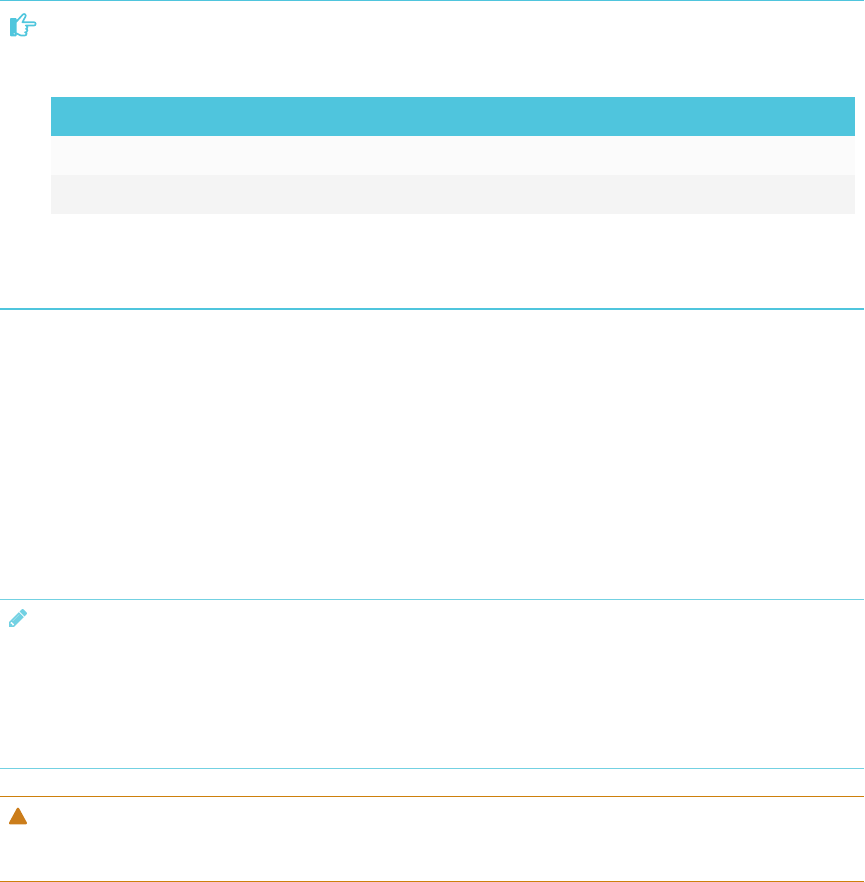
IMPORTANT INFORMATION
iii smarttech.com/kb/171164
IMPORTANT
lThe following are the normal operating power requirements for the display:
Model Power requirements
SBID-7075 100V to 240V AC, 50 Hz to 60 Hz, 147 W
SBID-7275 100V to 240V AC, 50 Hz to 60 Hz, 162 W
lFor additional requirements and other information, refer to the display’s specifications (see
More information on page9).
Federal Communication Commission
interference statement
This device complies with Part 15 of the FCC Rules. Operation is subject to the following two conditions:
1. This device may not cause harmful interference, and
2. this device must accept any interference received, including interference that may cause undesired operation.
NOTE
This equipment has been tested and found to comply with the limits for a Class A digital device, pursuant to part 15 of the
FCC Rules. These limits are designed to provide reasonable protection against harmful interference when the equipment is
operated in a commercial environment. This equipment generates, uses, and can radiate radio frequency energy and, if not
installed and used in accordance with the instruction manual, may cause harmful interference to radio communications.
Operation of this equipment in a residential area is likely to cause harmful interference in which case the user will be
required to correct the interference at his own expense.
CAUTION
Any changes or modifications not expressly approved by the party responsible for compliance could void the user’s
authority to operate this equipment.
Radiation exposure statement – model SBID-7075
This equipment complies with FCC radiation exposure limits set forth for an uncontrolled environment. This equipment should
be installed and operated with minimum distance of 20 cm between the antenna of this device and all nearby persons. This
transmitter must not be co-located or operated in conjunction with any other antenna or transmitter.
Innovation, Science and Economic Development
Canada statement
This device complies with RSS-247 of the Innovation, Science and Economic Development Canada Rules. Operation is subject
to the following two conditions:
1. This device may not cause harmful interference, and
2. this device must accept any interference received, including interference that may cause undesired operation.

IMPORTANT INFORMATION
iv smarttech.com/kb/171164
Radiation exposure statement – model SBID-7075
This equipment complies with ISED radiation exposure limits set forth for an uncontrolled environment. This equipment should
be installed and operated with minimum distance of 20 cm between the antenna of this device and all nearby persons. This
transmitter must not be co-located or operated in conjunction with any other antenna or transmitter.
Cet appareil est conforme à la norme ISED CNR-247 pour les appareils radio agréés. Son fonctionnement est soumis aux deux
conditions suivantes:
1. le dispositif ne doit pas produire de brouillage préjudiciable, et
2. ce dispositif doit accepter tout brouillage reçu, y compris un brouillage susceptible de provoquer un fonctionnement
indésirable.
Déclaration d’exposition aux radiations – model SBID-7075
Cet équipement est conforme aux limites d’exposition aux rayonnements ISED établies pour un environnement non contrôlé.
Cet équipement doit être installé et utilisé avec un minimum de 20 cm de distance entre la source de rayonnement et votre
corps. Cet émetteur ne doit pas être co- implantés ou exploités conjointement avec une autre antenne ou émetteur.
CE
Products bearing the CE marking comply with one or more of the following EU Directives:
RED 2014/53/EU; RoHS Directive 2011/65/EU.
Compliance with these directives is assessed using applicable European Harmonised Standards. The full Declaration of
Conformity can be found at smarttech.com/compliance.
Radio frequency band and maximum power level:
Transmitting Band (MHz) Maximum Transmit Power EIRP (dBm)
2402–2483.5 4.0

v smarttech.com/kb/171164
Contents
Important information i
Federal Communication Commission interference statement iii
Innovation, Science and Economic Development Canada statement iii
CE iv
Chapter 1: Welcome 1
About this guide 1
About the display 2
Components 3
Related products 8
More information 9
Chapter 2: Installing the display 11
Transporting the display 11
Installing the display on a wall 13
Installing the display on a stand 18
Chapter 3: Connecting power and devices 19
Connecting power 20
Connecting to a network 20
Connecting cables for room computers, guestlaptops and other input sources 21
Connecting external speakers 23
Connecting other devices 24
Connector reference 25
Chapter 4: Configuring the display 29
Turning on the display for the first time 29
Connecting to a network 30
Updating system software 35
Switching to the Beta channel 36
Adding or removing apps from the launcher 38
Enabling the Whiteboard Library 38
Chapter 5: Configuring connected computers 39
Installing SMART software on connected computers 39
Setting connected computers’ resolutions and refresh rates 40
Chapter 6: Maintaining the display 41
Checking the display installation 41

CONTENTS
vi smarttech.com/kb/171164
Cleaning the display 41
Maintaining ventilation 42
Preventing condensation 42
Replacing the pens and eraser 43
Turning the display off and back on 43
Resetting the display 44
Removing and transporting the display 44
Chapter 7: Troubleshooting 47
Troubleshooting the display 47
Troubleshooting the display’s software 50
Referring to the SMART knowledge base for additional troubleshooting information 60
Contacting your reseller for additional support 61
Appendix A: Using settings 63
About device 63
Diagnostics 64
Language 64
Country 65
Security 65
Wi-Fi 66
Advanced Wi-Fi options 67
Ethernet 67
Date & time 68
Usage Data 68
Auto Update 69
Display 69
Audio 69
Launcher 70
SMARTiQ Whiteboard 70
Screen Share 71
Appendix B: Remotely managing the display 73
Connecting a computer to the display 74
Connecting multiple displays 75
Configuring the computer’s serial interface settings 75
Power states 76
Commands and responses 76
Commandinventory 79
Resolving issues with remote management 81
Appendix C: Hardware environmental compliance 83
Waste Electrical and Electronic Equipment (WEEE) 83
Batteries 83

Chapter 1
1 smarttech.com/kb/171164
Chapter 1: Welcome
About this guide 1
About the display 2
Features 2
Models 3
Components 3
iQ appliance 4
Screen 4
Home button 4
Pens 5
Eraser 6
Convenience panel 6
Presence detection sensors 7
Internal speakers 8
Related products 8
SBA-100 projection audio system 8
SMART Audio 400 classroom amplification system 8
USB extenders 9
More information 9
This chapter introduces the SMARTBoard® 7000 series interactive display.
About this guide
This guide explains how to install and maintain a SMARTBoard 7000 series interactive display with
iQ. It includes the following information:
lHow to install the display
lHow to connect power and devices
lHow to turn on the display for the first time and configure the iQ appliance
lHow to maintain the display for years of use
lHow to troubleshoot issues with the display

CHAPTER 1
WELCOME
2 smarttech.com/kb/171164
In addition, this guide includes information on the display’s settings and remote management
support.
This guide is intended for those who install and maintain displays in their organizations. Other
documentation and resources are available for those who use displays (see More information on
page9).
About the display
The SMARTBoard 7000 series interactive display is the hub of your classroom. iQ technology
connects devices, lesson content and pedagogically relevant software to create a cohesive
educational experience. PC-free embedded computing provides one-touch access to a diverse
suite of SMART applications—Notebook lessons, amp workspaces, lab gamification activities and
whiteboard—and collaborative tools, such as wireless screen sharing and a web browser. There’s
no need for wires, cables or manual software and firmware updates.
Features
The display includes the following features:
Feature Description
iQ technology The display’s iQ appliance connects devices, lesson content and
pedagogically relevant software to create a cohesive educational
experience.
Touch support You can do everything on the display that you can do at your
computer—open and close applications, meet with others, create
new documents or edit existing ones, visit websites, play and
manipulate videos, and so on—by touching the display’s surface.
You can use an array of gestures within applications, including
panning, scaling, rotating and zooming in and out.
The display’s support for up to 10 simultaneous touch, writing and
erase points enables you and other users to interact with objects
on the screen at the same time.
Writing and drawing
support
You can write over applications in digital ink using one of the
supplied pens, and then erase the digital ink using your palm, the
eraser or the erasers on the pens.
Up to four users can write or draw digital ink on the screen at the
same time. Each pen writes and draws in its own color. The PenID™
feature enables you to assign different ink appearances to each
pen.
Audio support The display includes integrated speakers for presenting audio from
connected input sources.
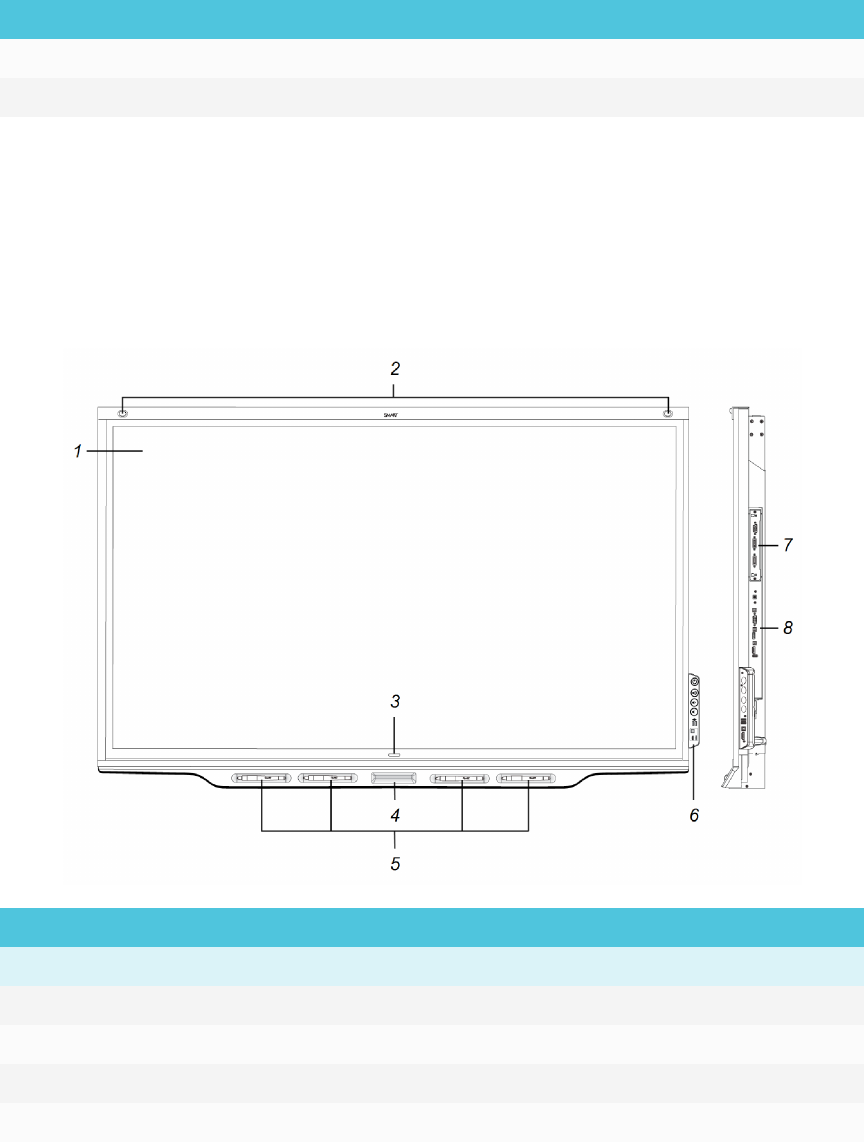
CHAPTER 1
WELCOME
3 smarttech.com/kb/171164
Models
The following models of SMARTBoard 6000 series interactive display are available:
Model Description
SBID-7075 SMARTBoard 7075 interactive display
SBID-7275 SMARTBoard 7075 interactive display with iQ
Refer to the specifications for detailed technical information for this model, including product
dimensions and weights (see More information on page9).
Components
The display consists of the following components:
No. Name More information
Pictured
1 Screen Page4
2 Presence detection sensor (×2) Page7
3 Home button Page4
4 Eraser Page6
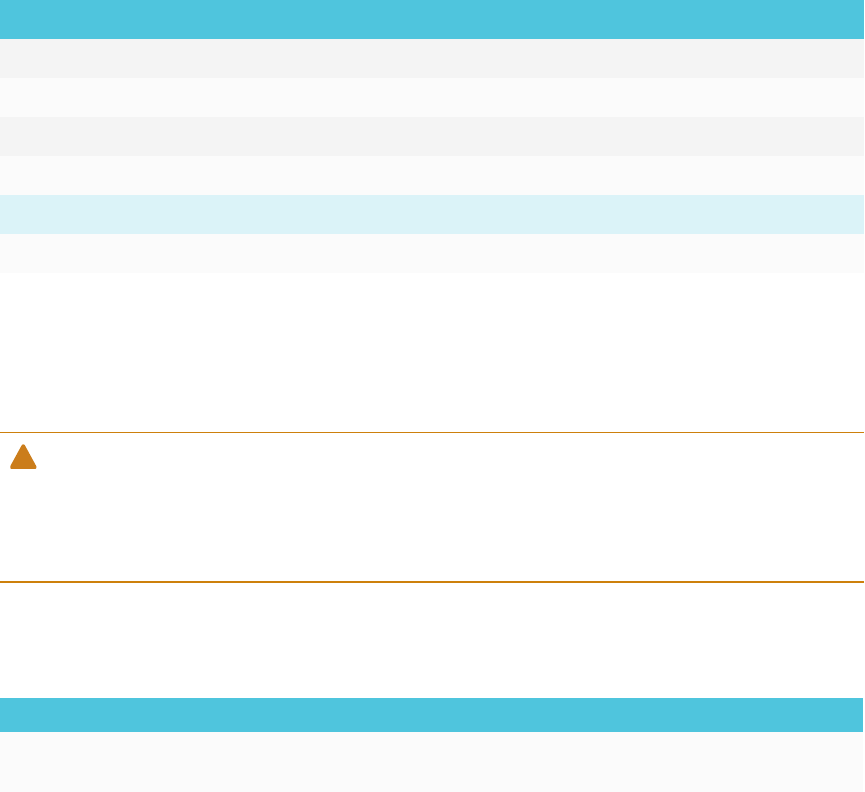
CHAPTER 1
WELCOME
4 smarttech.com/kb/171164
No. Name More information
5 Pen (×4) Page5
6 Convenience panel Page6
7 iQ appliance Page4
8 Connector panel Page25
Not pictured
9 Speakers Page8
iQ appliance
The iQ appliance is installed in the accessory slot on the back of the SBID-7275 model. Take
advantage of iQ technology and access SMART education software and other applications.
CAUTION
The accessory slot’s maximum available power is 60 W. The slot is not a limited power source.
To reduce the risk of fire, make sure that accessories connecting to the slot satisfy the fire
enclosure requirements of IEC60950-1.
Screen
The following are the dimensions and aspect ratio for the display:
Models Diagonal Width Height Aspect ratio
SBID-7075
SBID-7275
75" (190.5 cm) 65" (165.2 cm) 38 5/8" (93 cm) 16:9
The display’s HyPrTouch™ (HybridPrecisionTouch) technology enables you to interact with
objects on the screen and write and draw in digital ink.
Home button
Tap the Home button to open the launcher. From the launcher, you can open the iQ appliance’s
apps as well as the settings.
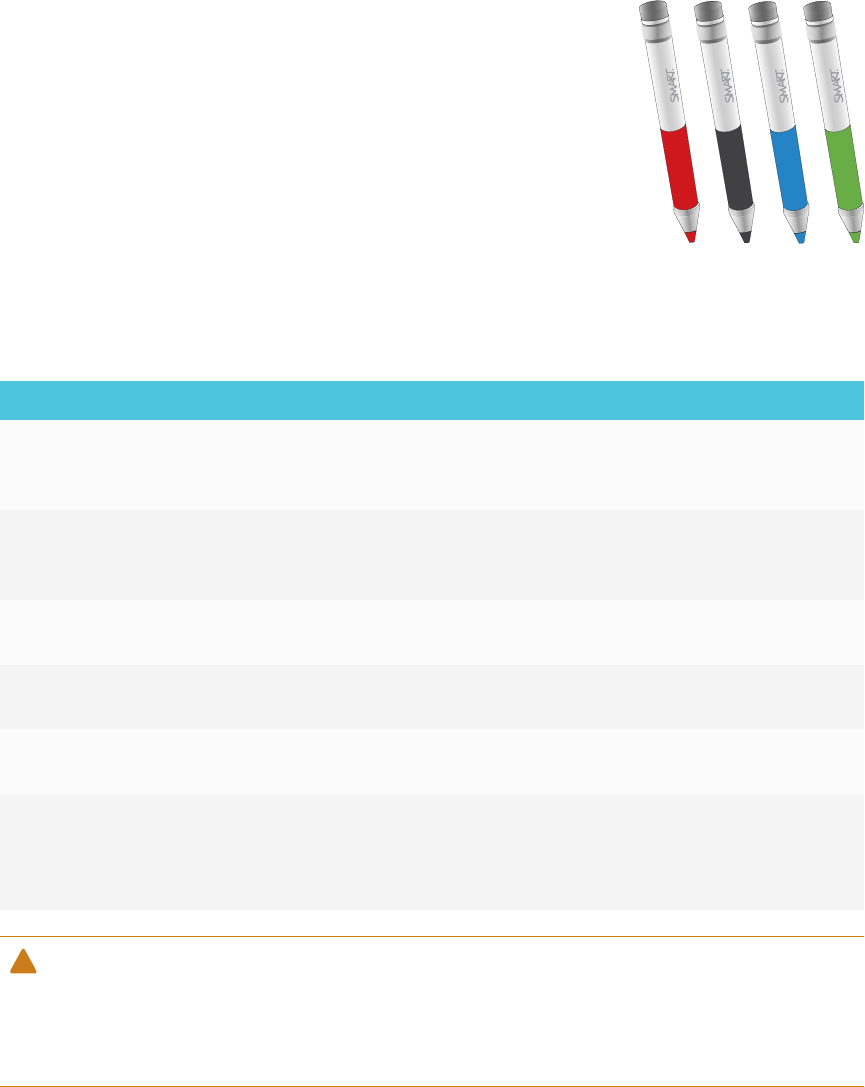
CHAPTER 1
WELCOME
5 smarttech.com/kb/171164
Pens
The display comes with black, red, blue and green pens. Each pen has
an attached eraser and an indicator light.
The display’s bottom frame includes magnetic holders for the pens.
Removing a pen from its holder activates it, and you can use the pen to
draw or erase digital ink. Replace the pen when you’re done using it to
charge it.
When you first turn on the display or pick up a pen from the magnetic holder, the pen’s light turns
on to indicate the pen’s status:
Light Pen status Action
Solid green The pen is charged and can
be used for at least one
hour.
Pick up the pen and use it to write on the
display. Return the pen to the magnetic holder
when you’re done.
Solid amber The pen is charging but can
be used for up to 30
minutes.
Use the pen for a few minutes. Return the pen
to the magnetic holder when done.
Solid red The pen needs to be
charged within an hour.
Finish using the pen and return it to the
magnetic holder when done.
Flashing red The pen needs to be
charged within 10 minutes.
Return the pen to the magnetic holder as soon
as possible.
Flashing green
and red
The pen has not been
paired with the display.
Place the pen in the magnetic holder to pair it
with the display.
Flashing in any
color (while the
pen is in the
magnetic holder)
The pen’s firmware is
updating.
Wait 30 seconds for the pen’s firmware to
complete updating.
CAUTION
When you return a pen to the magnetic holder, make sure it’s centered in its holder to keep it
from falling and being damaged. The pen’s light turns on to indicate that it’s properly positioned
in the holder.
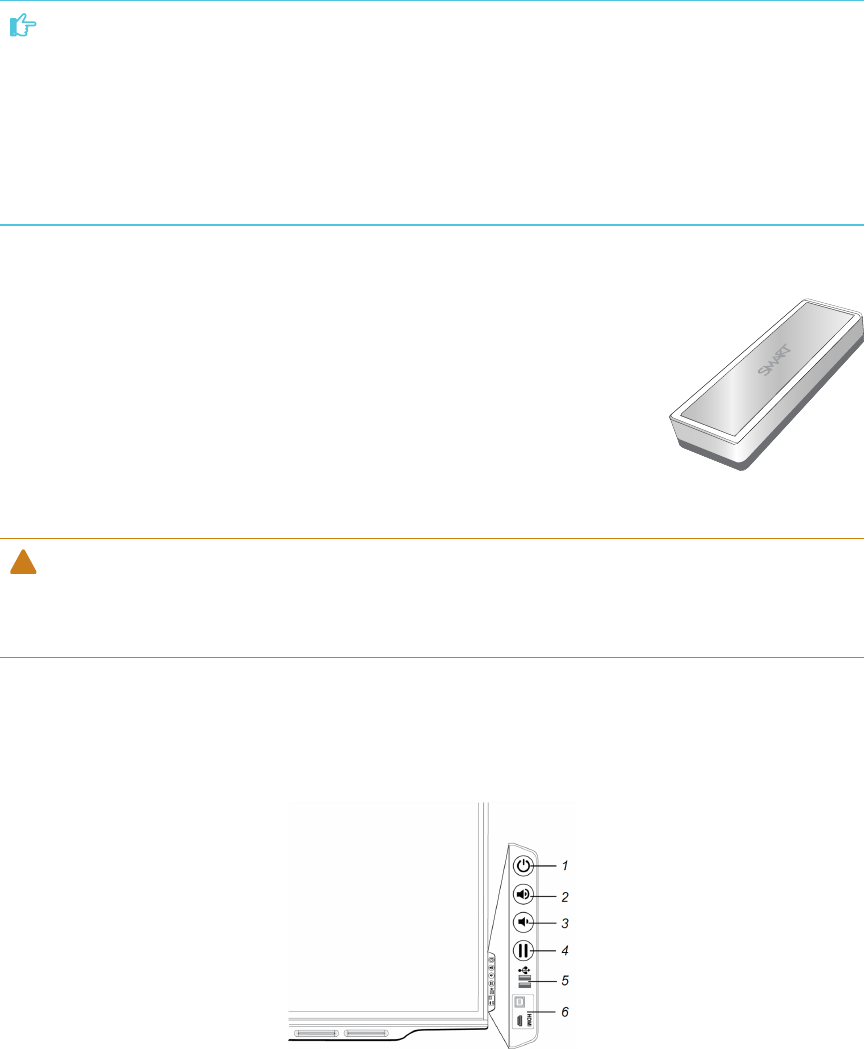
CHAPTER 1
WELCOME
6 smarttech.com/kb/171164
IMPORTANT
lAfter you install the display and turn it on for the first time, place the pens in the holders for
at least one minute. This pairs the pens with the display and charges them for testing
purposes.
lTo fully charge the pens, keep them in the holders for at least four hours before users start
using the display.
Eraser
In addition to the pens, the display includes an eraser, which you can use
when you want to erase a large area on the screen.
The display’s bottom frame includes a magnetic holder for the eraser.
Replace the eraser when you’re done with it.
CAUTION
When you return the eraser to the magnetic holder, make sure it’s centered in its holder to keep
it from falling and being damaged.
Convenience panel
The convenience panel contains buttons for turning the display on and off and controlling the
volume. It also includes connectors for USB peripherals and a computer or other input source.
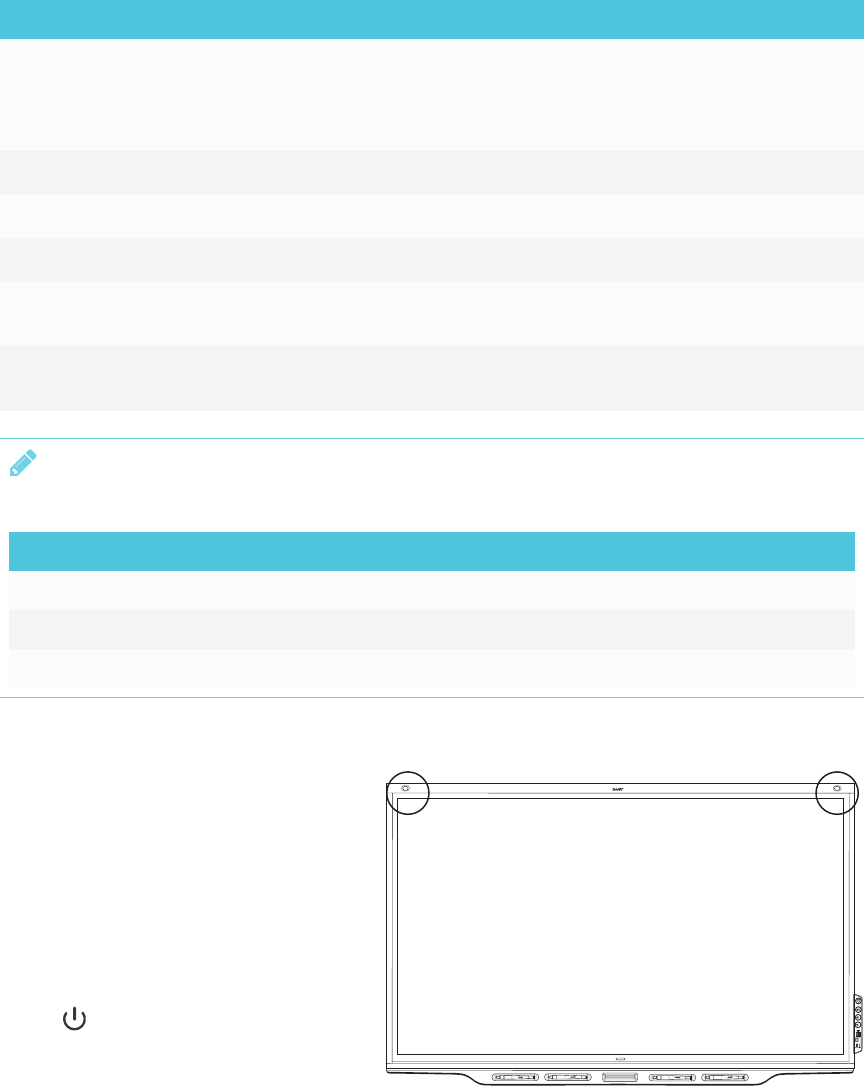
CHAPTER 1
WELCOME
7 smarttech.com/kb/171164
No. Name Procedure
1 Power lPress to enter or exit Standby mode.
lPress and hold for four seconds to turn off the display.
lPress and hold for 10 seconds to reset the display.
2 Volume increase Press to increase the volume.
3 Volume decrease Press to decrease the volume.
4Freeze Press to freeze and unfreeze the screen.
5 USB Type A
connector (×2)
Connect USB drives and other devices that you want to use
with the iQ appliance or a connected computer.
6 HDMI 2 input
connectors
Connect a computer or other input source to use with the
display (see page21).
NOTE
The Power button indicates the display’s status:
Power button Display status
Off Not receiving power
Amber Standby mode
White Normal operating mode
Presence detection sensors
The display has two presence detection
sensors on its top frame that can detect
people up to 16' (5 m) away when the
display is in Standby mode.
When the sensors detect people in the
room, the display is ready to turn on. To
turn on the display, press the Power
button or pick up a pen or eraser.
If the room is empty for a specified
period, the display returns to Standby
mode.
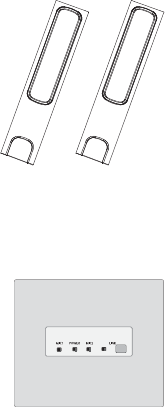
CHAPTER 1
WELCOME
8 smarttech.com/kb/171164
Internal speakers
The display includes two 10 W integrated speakers. You can also connect external speakers (see
Connecting external speakers on page23).
Related products
Related products for the display include the following:
lSBA-100 projection audio system
lSMART Audio 400 classroom amplification system
lUSB extenders
SBA-100 projection audio system
The SBA-100 projection audio system consists of two 14 W speakers and is
intended for wall-mounted displays. You can control volume using the
display’s convenience panel or the digital volume controls in a connected
computer’s operating system.
For more information, see the SBA-100 projection audio system specifications
(smarttech.com/kb/171146).
SMART Audio 400 classroom amplification system
The SMART Audio 400 classroom amplification system provides high-quality
audio amplification. The system comes with a teacher microphone and optional
student microphone. Multiple speaker options are available, including wall- and
ceiling-mounted speakers. The amplifier receives audio signals from the
microphones and translates them into crystal-clear sound through the speakers.
For more information, see the SMART Audio 400 classroom amplification system specifications
(smarttech.com/kb/171137).

CHAPTER 1
WELCOME
9 smarttech.com/kb/171164
USB extenders
As noted in Connecting cables for room computers, guestlaptops and other input sources on
page21, the USB connection between the display and computer should be no longer than 16'
(5m). If you need to connect a computer that is more than 16' (5 m) from the display, use one of the
following USB extenders:
Extender Specifications
USB-XT smarttech.com/kb/119318
CAT5-XT-1100 smarttech.com/kb/170202
More information
In addition to this guide, SMART provides the following documents for the display:
Document Link
Quick reference smarttech.com/kb/171162
User’s guide smarttech.com/kb/171163
Installation instructions smarttech.com/kb/171160
SBID-7075 specifications smarttech.com/kb/171131
SBID-7275 specifications smarttech.com/kb/171133
Comparison smarttech.com/kb/171161
These documents are available in the Support section of the SMART website
(smarttech.com/support). Scan the QR code on the cover of this guide to view the SMARTBoard
7000 series interactive display with iQ pages in the Support section.
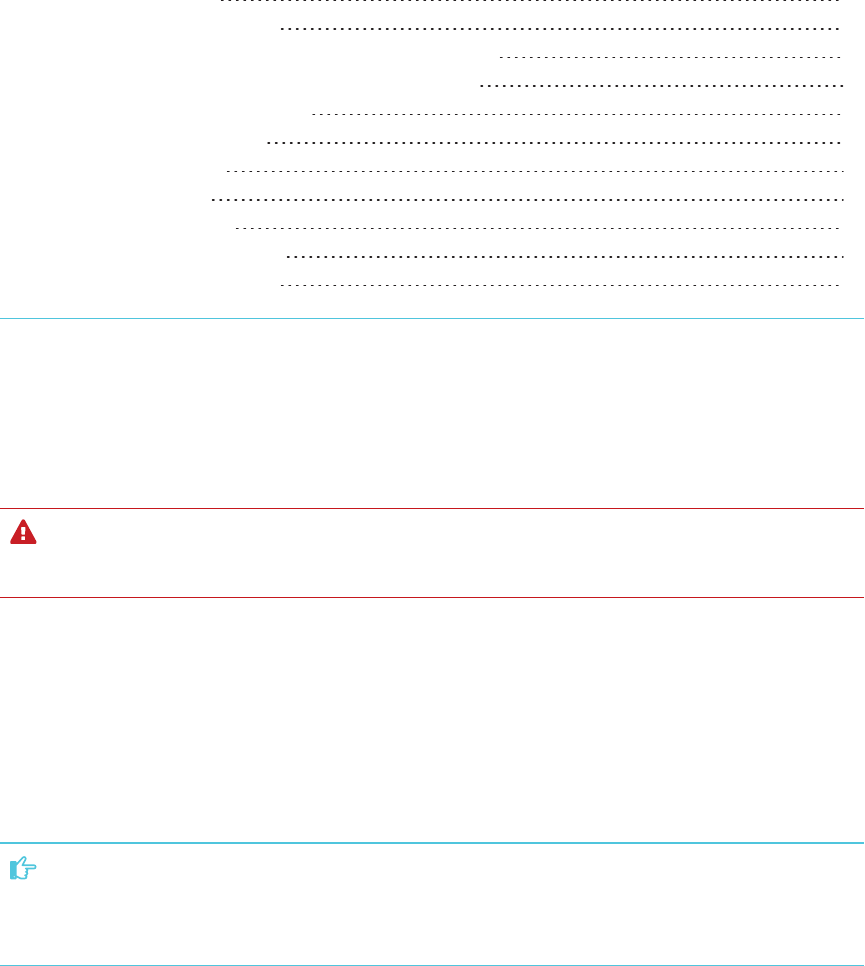
Chapter 2
11 smarttech.com/kb/171164
Chapter 2: Installing the display
Transporting the display 11
Using transportation aides 12
Accommodating doorways, hallways and elevators 12
Dealing with cracked, chipped or shattered glass 13
Saving the original packaging 13
Installing the display on a wall 13
Choosing a location 14
Choosing a height 15
Mounting the display 16
Mounting multiple displays 17
Installing the display on a stand 18
SMART recommends that only trained installers install the display.
This chapter is for installers. Installers should read this information along with the installation
instructions included with the display before they install the display.
WARNING
Improper installation of the display can result in injury and product damage.
Transporting the display
After your organization receives the display, you need to transport it to the place where you plan
to install it.
On occasion, you might also need to move the display to another location after initially installingit.
IMPORTANT
lTransport the display at your own risk. SMART cannot accept liability for damages or injury
that occur during the display’s transportation.

CHAPTER 2
INSTALLING THE DISPLAY
12 smarttech.com/kb/171164
lWhen transporting the display, do the following:
oFollow local safety regulations and standards.
oKeep the display in its original packaging.
oMove the display so that its top frame faces up.
oHave at least two people move the display.
Using transportation aides
You can use the following aides to transport the display:
lCart
lFurniture dolly
lMechanical lift
NOTE
The display features eyebolt mounting holes for use with mechanical
lifts. Refer to the installation instructions for information on using a
mechanical lift.
Accommodating doorways, hallways and elevators
In some situations, you might need to remove the display from its packaging to move it through
narrow doorways or hallways or on to an elevator. In these situations, SMART recommends that
you keep the foam pieces on the bottom corners of the display. These foam pieces protect the
display if you need to set it down during transport.
You might also need to rotate the display so that its top frame faces to the side. You can do this
during transportation, but when you install the display, it must be in landscape orientation (with the
top frame facing up).

CHAPTER 2
INSTALLING THE DISPLAY
13 smarttech.com/kb/171164
Dealing with cracked, chipped or shattered glass
The display contains safety-tempered glass. Although this glass is heat-strengthened to help
withstand impacts, the glass can crack, chip or shatter if struck with enough force. (Safety glass is
designed to break into small pieces rather than sharp shards if it is broken.) Temperature changes
can cause a minor crack or chip to become worse, possibly causing the glass to shatter. See
Shattered glass on an interactive display for information about conditions that can cause the
display’s glass to shatter even when it’s not in use.
If the display’s glass is cracked or chipped, have it professionally inspected and repaired at a
SMART authorized repair center. If the display’s glass shatters, carefully clean up the area and have
the display repaired or replaced.
CAUTION
For safety and to prevent further damage, do not continue to install or use the display if its glass
is cracked, chipped or shattered.
Saving the original packaging
Save the original packaging to repack the display with as much of the original packaging as
possible in case you need to transport the display again after you initially install it. This packaging
was designed to provide the best possible protection against shock and vibration.
CAUTION
Transport the display only in original or replaced packaging. Transporting the display without
correct packaging can lead to product damage and voids the warranty.
NOTE
If the original packaging isn’t available, you can purchase the same packaging directly from your
authorized SMART reseller (smarttech.com/where).
Installing the display on a wall
Typically, you install the display on a wall in a classroom or meeting space.

CHAPTER 2
INSTALLING THE DISPLAY
14 smarttech.com/kb/171164
Choosing a location
A display is typically installed at the room’s focal point, such as at the front of a classroom.
Selecting an appropriate location for the display is crucial for ensuring the best possible
experience with the product. Consider the following factors as you choose a location:
Factor Considerations
Room setup lThe location allows teachers and students, including those in
wheelchairs, to access the display.
lThe location is clearly visible to all students in the classroom. For more
information, see Recommended viewing distances and viewing angles
for SMARTBoard interactive displays.
lThe display will not be installed where it could be hit by a door or gate.
lThere are no nearby shelving units, desks or other furniture that has
doors or drawers that could hit the display.
Wall support The wall can support the weight of the display and mounting equipment.
Refer to the model’s specifications for the weight of the display (see
More information on page9).
Power and other
connections
lThe location is close to the following:
oA power outlet
oA network outlet (if you plan to use a wired network connection)
oA room computer (if you plan to connect a room computer)
oSpeakers and other devices that you want to connect to the display
lThe location is not where the mains power supply enters the building.
Lighting The location is not near bright light sources, such as windows or strong
overhead lighting. Infrared (IR) lighting can cause issues with presence
detection.
Acoustics The location has good acoustics.
TIP
Stand in different parts of the room and count to ten loudly. If you hear
anything other than your own voice (such as a rattle, buzzing from
elsewhere in the room or echoes), the room may require some
modifications to improve the acoustics. Work with an audio specialist
to improve the acoustics.
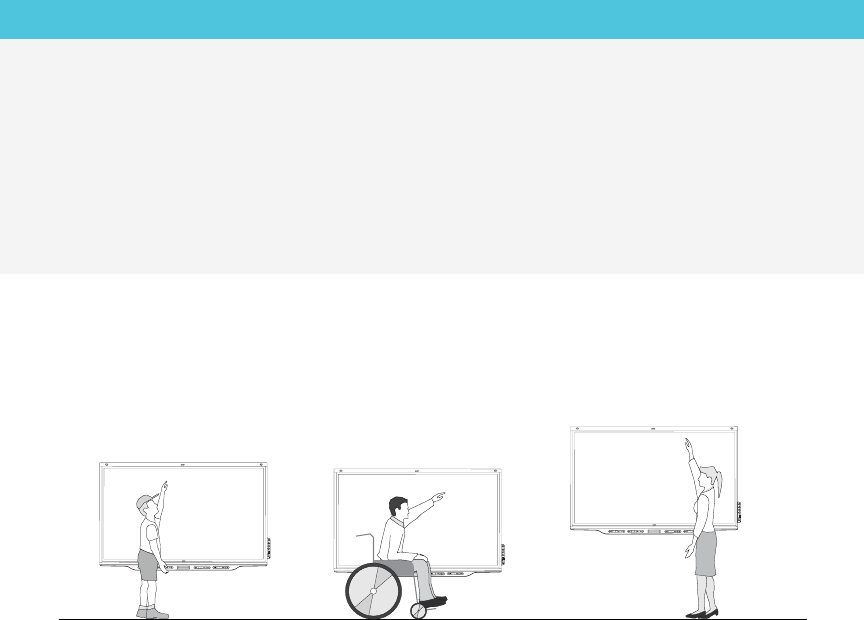
CHAPTER 2
INSTALLING THE DISPLAY
15 smarttech.com/kb/171164
Factor Considerations
Environment and
ventilation
lThe location meets the environmental requirements in the display’s
specifications (see More information on page9).
lThe display isn’t subjected to strong vibrations or dust.
lThere is adequate ventilation or air conditioning around the display so
that heat can flow away from the unit and the mounting equipment.
lIf you’re planning to install the display in a recessed area, there is at least
4" (10 cm) of space between the display and the recessed walls to
enable ventilation and cooling.
Choosing a height
Consider the general height of the user community when you choose the height for the display.
SMART recommends that you mount the display so that its top is 6'5" (1.9m) from the floor.
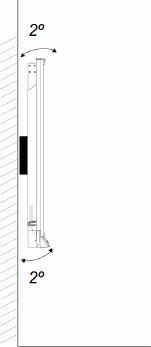
CHAPTER 2
INSTALLING THE DISPLAY
16 smarttech.com/kb/171164
Mounting the display
Mount the display following the included installation instructions. In addition, consider the
following:
lMount the display vertically (90° relative to the floor plus or minus 2° for tolerance) and in
landscape orientation. SMART doesn’t support mounting the display at other angles or in
portrait orientation.
lUse a standard VESA mounting plate.
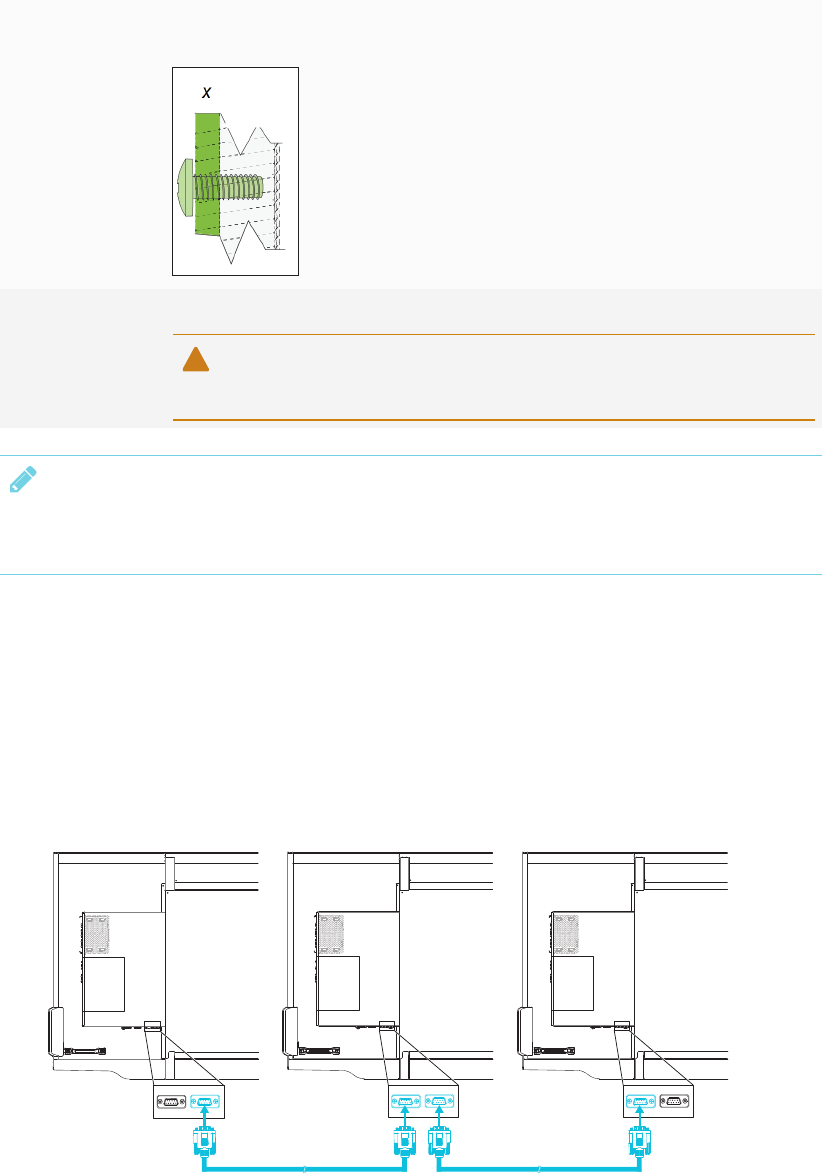
CHAPTER 2
INSTALLING THE DISPLAY
17 smarttech.com/kb/171164
lUse M8 screws to fasten the wall bracket.
Screw length 12 mm + xmm < M8 < 45 mm + xmm
where xis the combined thickness of the wall bracket and washer
Fasten force 97.36–177.01 in-lb. (11–20 N·m)
CAUTION
Do not over-tighten the screws.
NOTE
SMART recommends M8 × 30 mm mounting screws for standard installations where the
total wall mount bracket and washer thickness is less than 7 mm.
lBecause the receptacles might not be easily accessible after you mount the display, consider
connecting cables for power, room computer and other devices while the display is still in its
packaging (see Chapter 3: Connecting power and devices on page19).
Mounting multiple displays
If you mount multiple displays side by side, connect the displays using RS-232 cables. This will
allow you to turn on, turn off and otherwise operate all of the displays from the right-most display’s
convenience panel.

CHAPTER 2
INSTALLING THE DISPLAY
18 smarttech.com/kb/171164
NOTE
For more information on using RS-232 cables for remote management, see Appendix B:
Remotely managing the display on page73.
Installing the display on a stand
If you want to move the display from place to place or if it’s not possible to install the display on a
wall, you can install it on a stand.
IMPORTANT
If you install the display on a stand, do not move the stand while the display is on.
For information on selecting and using a third-party stand, see SMART installation standards
(smarttech.com/kb/171035).

Chapter 3
19 smarttech.com/kb/171164
Chapter 3: Connecting power and devices
Connecting power 20
Connecting to a network 20
Connecting cables for room computers, guestlaptops and other input sources 21
Using recommend cables 22
Connecting to the connector panel 22
Connecting to the convenience panel 23
Viewing a connected computer or other device’s input 23
Connecting external speakers 23
Connecting other devices 24
Connector reference 25
Display connectorpanel 25
Display convenience panel 26
iQ appliance 26
Other connectors 27
Connect the display to power after you install it but before you turn it on for the first time and
configure the iQ appliance. You can also connect cables for room computers, guest laptops or
other input sources as well as for speakers and other devices.
By installing cables in advance, you make use of connectors that might not be accessible after the
display is wall-mounted. You can then run the cables across floors or behind walls as needed.
WARNING
Ensure that any cables that cross the floor to the display are properly bundled and marked to
avoid a trip hazard.
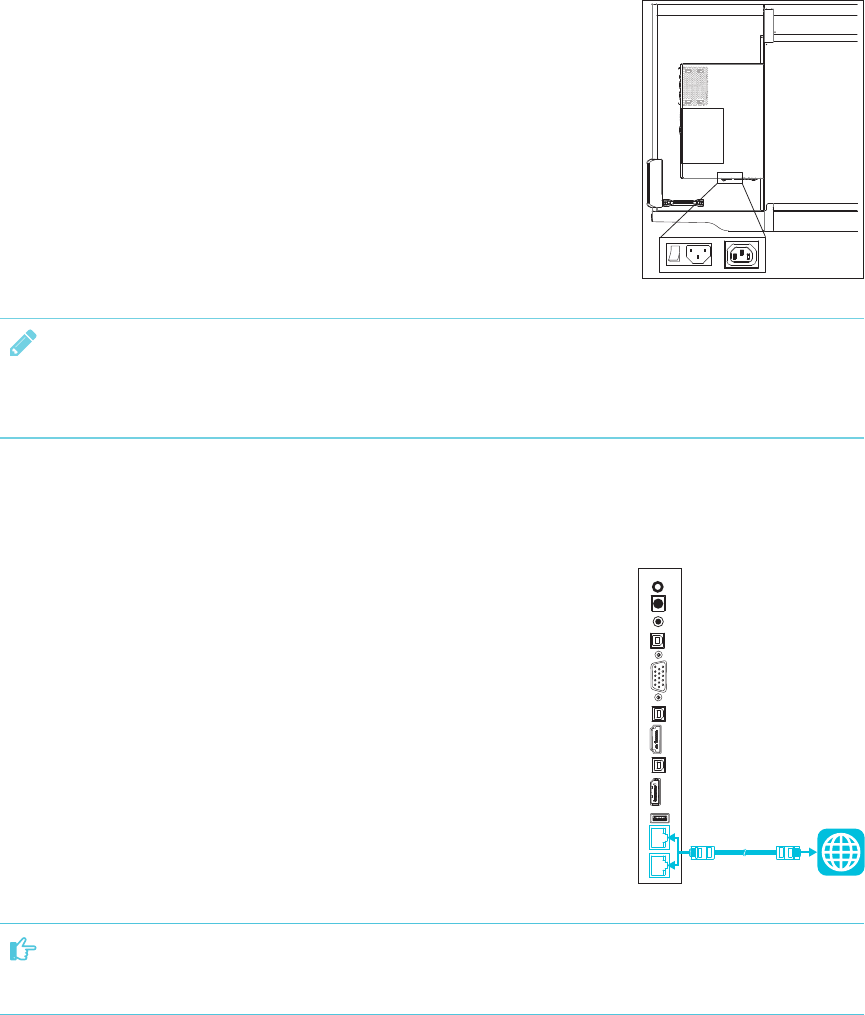
CHAPTER 3
CONNECTING POWER AND DEVICES
20 smarttech.com/kb/171164
Connecting power
Connect the supplied power cable from the AC power inlet on the
bottom of the display to a power outlet.
NOTE
Refer to the display’s specifications for power requirements and power consumption information
(see More information on page9).
Connecting to a network
The display requires a network connection for downloading software
and firmware updates, and a number of the iQ appliance’s apps require
a network connection as well. You can connect to a network using a
Wi-Fi connection or one of the RJ45 jacks on the display (pictured). For
more information about the display’s network connection and
configuration, see Connecting to a network on page30.
IMPORTANT
Do not use the RJ45 jack on the iQ appliance to connect to a network.
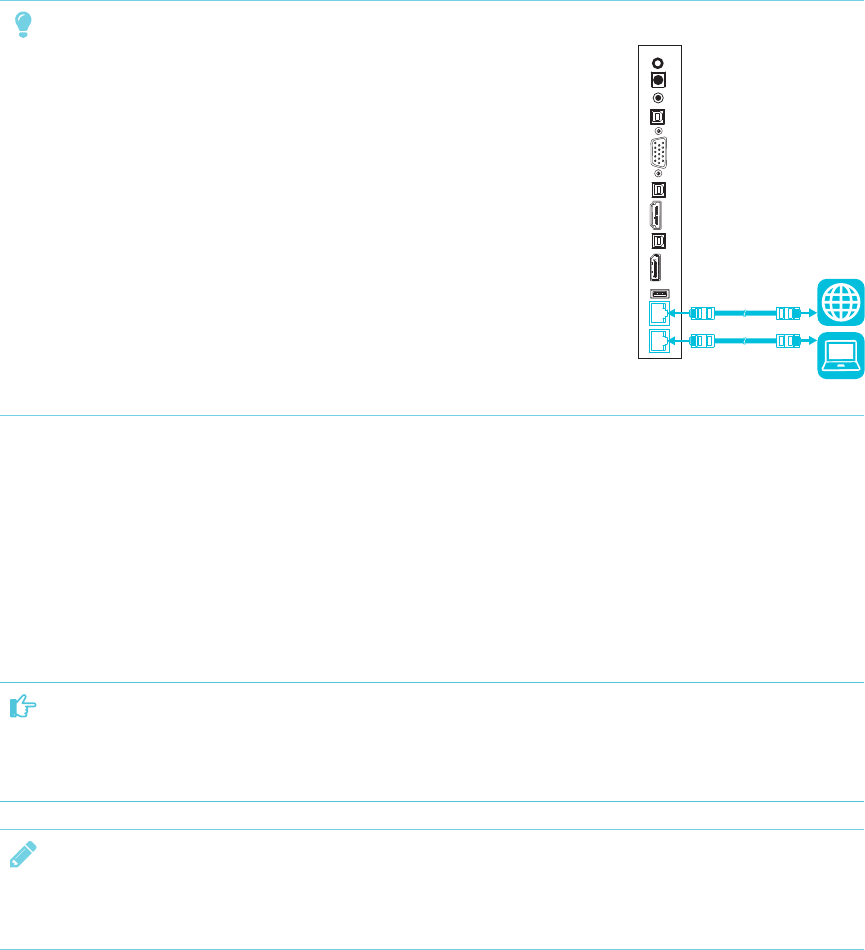
CHAPTER 3
CONNECTING POWER AND DEVICES
21 smarttech.com/kb/171164
TIP
If you’re using one of the display’s RJ45 jacks to connect to a network,
you can connect the other RJ45 jack to a computer to provide
network access for the computer. This is particularly useful if there is
only one wired network connection in the room.
Connecting cables for room computers,
guestlaptops and other input sources
You can connect cables to the display so that users can connect and use room computers, guest
laptops or other devices, such as Blu-ray™ disc players.
IMPORTANT
Do not connect computers or other devices to the iQ appliance. SMARTBoard 7000 series
interactive displays do not support the use of this connector.
NOTE
For information about configuring connected computers, see Chapter 5: Configuring connected
computers on page39.
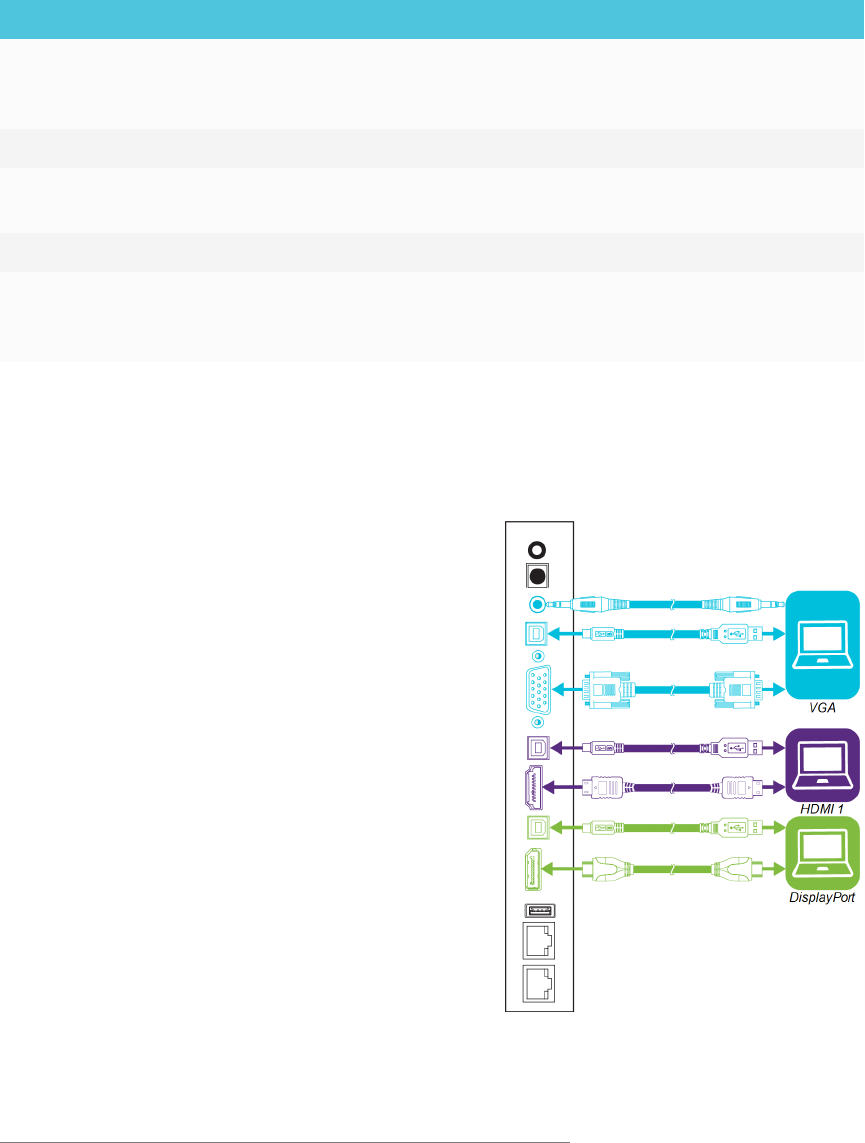
CHAPTER 3
CONNECTING POWER AND DEVICES
22 smarttech.com/kb/171164
Using recommend cables
SMART recommends the following varieties of cable:
Cable type Maximum length Recommendation
HDMI 23' (7 m)1Use only certified HDMI cables that have been
tested to support the performance standard you
require.
DisplayPort 23' (7 m) Use DisplayPort 1.2 compliant or better cables.
VGA [N/A] Use VGA cables with all pins in their connectors fully
populated and wired.
Stereo 3.5 mm 20' (6 m) [N/A]
USB 16' (5 m) Use a USB extender if the distance between the
computer and the display is greater than 16' (5 m).
For more information, see USB extenders on page9.
Using cables that exceed these maximum lengths may produce unexpected results, degraded
picture quality or degraded USB connectivity.
Connecting to the connector panel
The connector panel includes three sets of computer
connectors:
lVGA: This set of connectors can accommodate a
USBcable for touch control, a VGA cable for video
and a stereo 3.5 mm cable for audio.
lHDMI 1: This set of connectors can accommodate
a USB cable for touch control and an HDMI cable
for video and audio.
lDisplayPort: This set of connectors can
accommodate a USBcable for touch control and a
DisplayPort cable for video and audio.
1The performance of cables longer than 23' (7 m) is highly dependent on the cable’s quality.

CHAPTER 3
CONNECTING POWER AND DEVICES
23 smarttech.com/kb/171164
Connecting to the convenience panel
In addition to the three sets of computer connectors on
the connector panel, there is one set of computer
connectors on the convenience panel:
HDMI 2: This set of connectors can accommodate
a USBcable for touch control and an HDMI cable for
video and audio.
Viewing a connected computer or other device’s input
Users can use the Input app to view the computer or other device’s input on the display.
For information about the Input app, see the SMARTBoard 7000 series interactive display user’s
guide (smarttech.com/kb/171163).
Connecting external speakers
The display includes two 10 W speakers, which are designed to provide sound at the front of a
room. You might want to connect the SBA-100 projection audio system (see SBA-100 projection
audio system on page8) or third-party external active speakers if you’re providing sound in a
larger space.
You can connect external speakers to the display using the stereo
3.5mm out connector (pictured). Alternatively, you can connect
external speakers directly to a room computer.
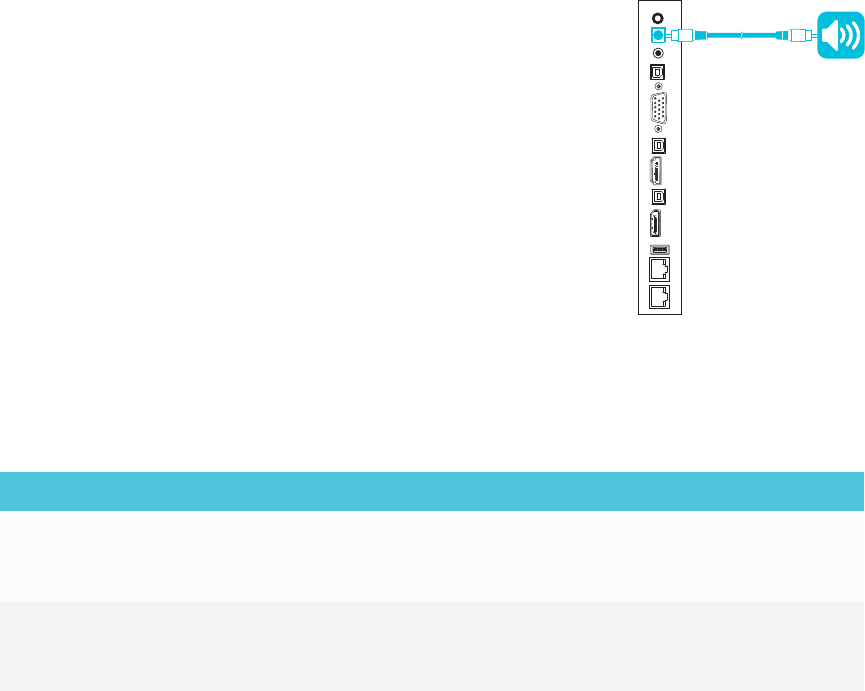
CHAPTER 3
CONNECTING POWER AND DEVICES
24 smarttech.com/kb/171164
In addition to the stereo 3.5 mm out connector, the display provides a
Sony/Philips Digital Interface (S/PDIF) out connector. S/PDIF is a digital
audio transmission medium. You need an audio receiver that supports
S/PDIF to decode this connection to analog for use with external
speakers.
Connecting other devices
In addition to external speakers, you can connect the following devices to the display:
Device type Details
Microphones Microphones can improve the audio experience in a classroom or lecture
hall. SMART offers a classroom audio system that includes microphones (see
SMART Audio 400 classroom amplification system on page8).
Room control
systems
Although SMART doesn’t offer room control equipment, the display supports
RS-232 communication for remote management (see Appendix B: Remotely
managing the display on page73).
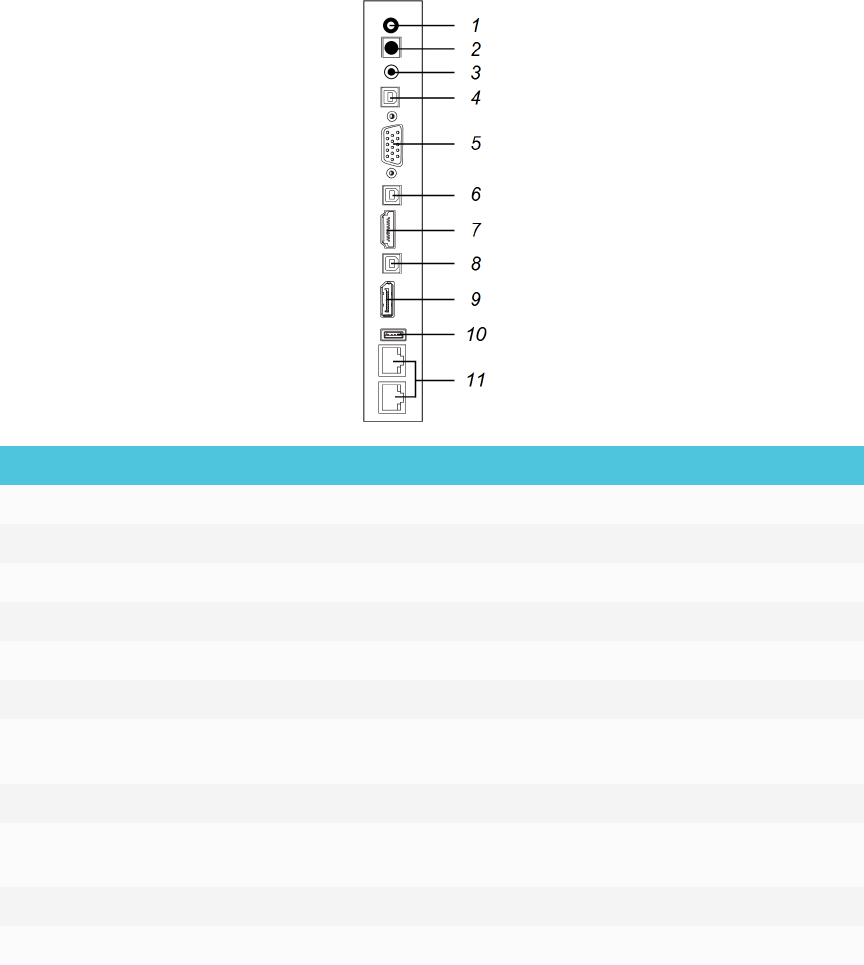
CHAPTER 3
CONNECTING POWER AND DEVICES
25 smarttech.com/kb/171164
Connector reference
Display connectorpanel
The following diagram and table present the connectors on the display’s connector panel:
No. Connector Connects to Notes
1 Stereo 3.5 mm out External speakers See page23.
2 S/PDIF out Digital audio output See page23.
3 Stereo 3.5 mm in VGA input (audio) See page21.
4 USB Type-B VGA input (touch) See page21.
5 VGA in VGA input (video) See page21.
6 USB Type-B HDMI 1 input (touch) See page21.
7 HDMI in HDMI 1 input
(videoandaudio)
See page21.
8 USB Type-B DisplayPort input (touch) See page21.
9 DisplayPort in DisplayPort input
(videoandaudio)
See page21.
10 USB Type-A [N/A] This connector is a service port.
11 RJ45 (×2) Network See page20.
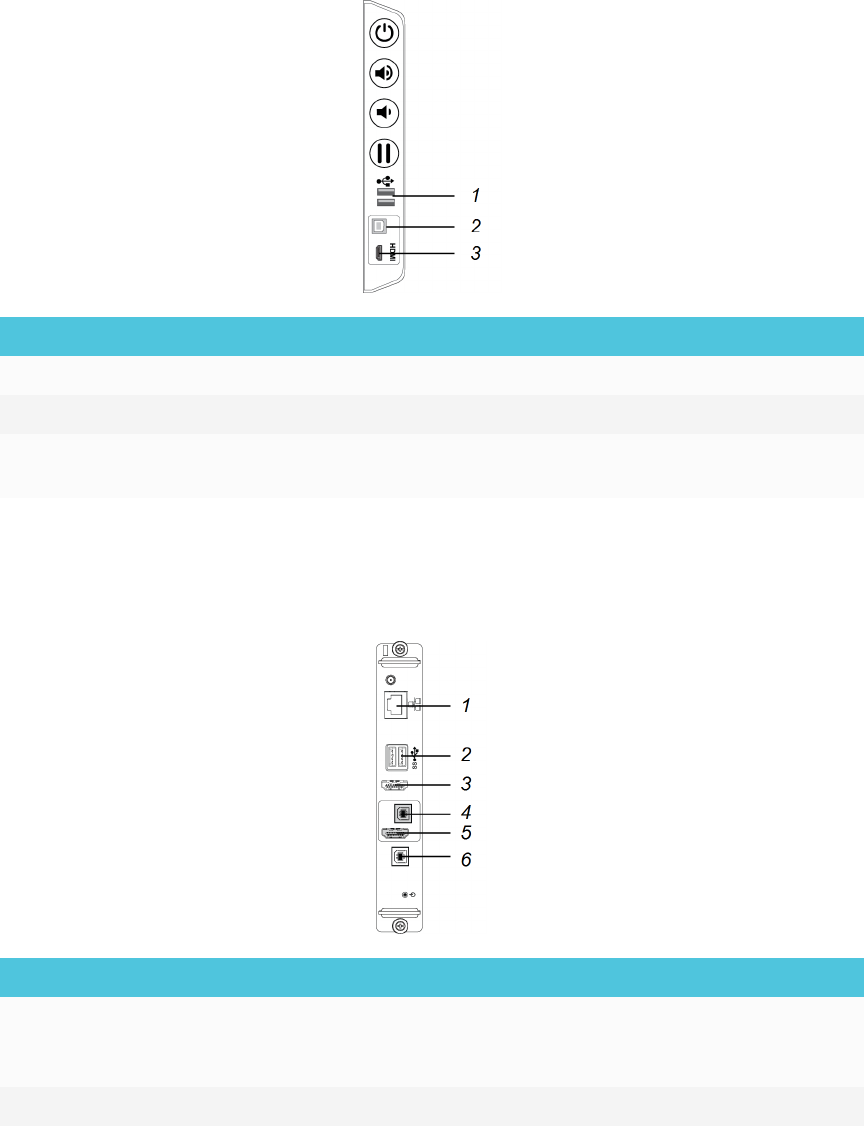
CHAPTER 3
CONNECTING POWER AND DEVICES
26 smarttech.com/kb/171164
Display convenience panel
The following diagram and table present the connectors on the display’s convenience panel:
No. Connector Connects to Notes
1 USB Type-A (×2) Supported peripherals [N/A]
2 USB Type-B HDMI 2 input (touch) See page21.
3 HDMI in HDMI 2 input
(videoandaudio)
See page21.
iQ appliance
The following diagram and table present the connectors on the iQ appliance:
No. Connector Connects to Notes
1 RJ45 Network Do not use this connector. Use
the connectors on the display
instead. See page20.
2 USB Type-A (×2) Supported peripherals [N/A]

CHAPTER 3
CONNECTING POWER AND DEVICES
27 smarttech.com/kb/171164
No. Connector Connects to Notes
3 HDMIout N/A This connector is not supported.
4 USB Type-B OPS/HDMI input (touch) Do not use this connector. Use
the connectors on the display
instead. See page21.
5 HDMI in OPS/HDMI input
(videoandaudio)
Do not use this connector. Use
the connectors on the display
instead. See page21.
6 USBType-B [N/A] This connector is a service port.
Other connectors
There are additional connectors on the bottom of the display (see Mounting multiple displays on
page17 and Appendix B: Remotely managing the display on page73).

Chapter 4
29 smarttech.com/kb/171164
Chapter 4: Configuring the display
Turning on the display for the first time 29
Connecting to a network 30
Configuring the network for the display 30
Configuring the network for iQ functions 30
Connecting the display to a network 33
Evaluating the impact of Screen Share on your network data usage 34
Updating system software 35
Applying an automatic system software update manually 35
Updating system software manually 36
Switching to the Beta channel 36
Before switching to the Beta channel 36
Switching between the Beta and Stable channels 36
Getting support and sending feedback 37
Adding or removing apps from the launcher 38
Enabling the Whiteboard Library 38
After you have mounted the display and connected power and devices, you can start it for the first
time and configure the apps as described in this chapter.
Turning on the display for the first time
Turn on the display after mounting it and connecting power and devices.
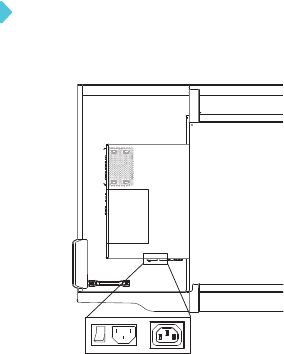
CHAPTER 4
CONFIGURING THE DISPLAY
30 smarttech.com/kb/171164
To turn on the display for the first time
1. Flick the switch beside the AC power inlet to the ON(I) position.
2. Select your preferred language, and then tap Next.
3. Select your country, and then tap Next.
4. Name the display, and then tap Next.
5. Set the date and time, and then tap Next.
6. If the display isn’t using a wired network connection, select a wireless network, and then tap
Next.
7. Select the list of applications that will appear in the launcher, and then tap Next. For more
information about the apps, see the SMARTBoard 7000 series interactive displays user’s
guide (smarttech.com/kb/171163)
8. Tap Finish.
The Welcome screen appears.
Connecting to a network
You can connect the display to a network using either Wi-Fi or an Ethernet connection. Before you
do so, your organization’s network administrators need to configure the network for the display.
Configuring the network for the display
Network administrators need to configure the network so users can use the Screen Share app,
update the system software automatically over the air and enable the display to set the date and
time automatically.
Configuring the network for iQ functions
Network administrators need to configure the network so users can update the display’s firmware
and system software automatically over the air and to allow apps to function properly.

CHAPTER 4
CONFIGURING THE DISPLAY
31 smarttech.com/kb/171164
To configure the network
Add these URLs to the network whitelist.
URL Feature
https://ws.kappboard.com
NOTE
Block access to https://ws.kappboard.com to
prevent automatic iQ system software updates
Automatic iQ system software update
https://*.mixpanel.com iQ system software
*.hockeyapp.net iQ system software
https://*.smarttech-prod.com SMARTNotebook® Player
http://*.loggly.com SMARTNotebook Player
http://*.smarttech.com iQ system software, Workspaces, app,
Activities app, SMARTNotebook Player
https://*.smarttech.com SMARTNotebook Player
https://www.fabric.io/ SMARTNotebook Player
https://*.classlab.com Workspaces app, Activities app
https://www.firebase.com/test.html Workspaces app, Activities app
https://*.smartamp.com Workspaces app, Activities app
https://*.google.com Activities app
http://*.google-analytics.com Activities app
https://www.gstatic.com Activities app
https://*.firebaseio.com Activities app
https://*.cloudfront.com Activities app
https://content.googleapis.com Workspaces app
https://gstatic.com Workspaces app
https://*.youtube.com Workspaces app, SMARTNotebook
Player
https://api.datamarket.azure.com Workspaces app

CHAPTER 4
CONFIGURING THE DISPLAY
32 smarttech.com/kb/171164
To allow mobile devices and computers to use AirPlay and Google Cast to use the Screen Share
app
1. Open the required TCP/UDP ports:
Protocol Port range Feature
TCP 80 Outbound http
UDP 123 Network Time Protocol
TCP 3689 iTunes music sharing
TCP 5000 Audio streaming
TCP 5353 mDNS
UDP 5353 mDNS
TCP 7000 Picture sharing
TCP 7001 Video streaming
UDP 7010 Display mirroring
UDP 7011 Display mirroring
TCP 7100 Display mirroring
TCP 47000 Audio negotiation
TCP 49152–65535 Dynamic ports
UDP 49152–65535 Dynamic ports
TCP 49228 Google Cast
TCP 50259 Google Cast
UDP 54780 Google Cast
UDP 62572 Google Cast
2. Configure the network to allow Bonjour and mDNS (multicast).
3. Configure the network to allow Network Time Protocol (NTP) requests to Internet time servers.
NOTE
Using a 5 GHz network connection may provide a better experience with the Screen Share
app.
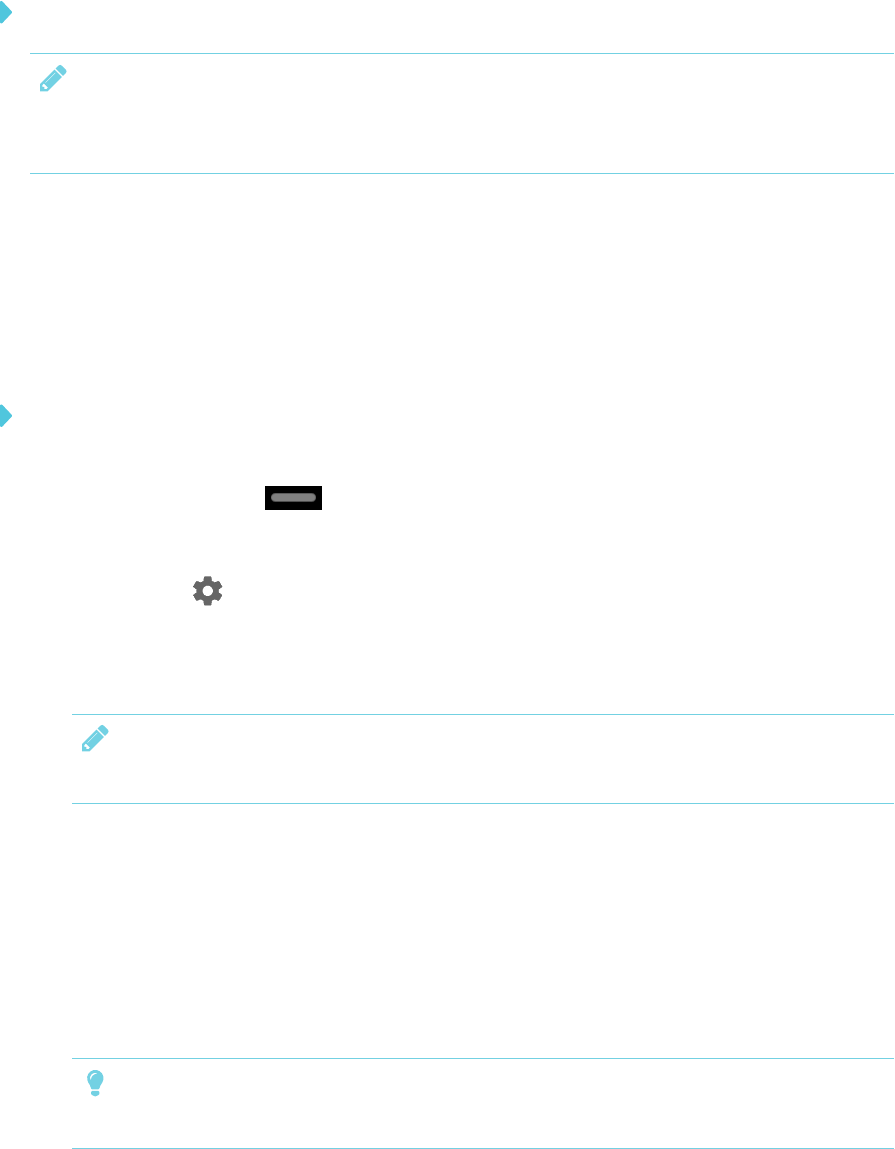
CHAPTER 4
CONFIGURING THE DISPLAY
33 smarttech.com/kb/171164
To allow SMARTNotebook Player to connect to the display
NOTE
The network may have been configured to allow Network Time Protocol in To allow mobile
devices and computers to use AirPlay and Google Cast to use the Screen Share app.
Configure the network to allow Network Time Protocol (NTP) requests to Internet time servers
Connecting the display to a network
The display can connect to a network using either Wi-Fi or an Ethernet connection. Network
administrators can also add a browser proxy.
To connect to a Wi-Fi network
1. If an Ethernet cable is connected to the display, disconnect it.
2. Tap the Home button on the screen.
The launcher appears.
3. Tap Settings .
The Settings window appears.
4. Tap Wi-Fi.
NOTE
Ensure Wi-Fi is turned On.
5. Select a wireless network.
If the Wi-Fi network is not password protected, the display connects to the network.
6. If the network requires a password, enter the Wi-Fi password and tap Connect.
OR
If the network requires a user name and password, enter the user name and Wi-Fi password
and tap Connect.
TIP
Use the crosshairs to move the on-screen keyboard.

CHAPTER 4
CONFIGURING THE DISPLAY
34 smarttech.com/kb/171164
To connect to an Ethernet network
Connect an Ethernet cable to the RJ45 receptacle on the display.
NOTE
The network must provide network settings via DHCP. If you require a static IP, use DHCP
reservation on your router.
To add a proxy
1. Tap the Home button on the screen.
The launcher appears.
2. Tap Settings .
The Settings window appears.
3. Tap Wi-Fi.
4. Tap and hold the network to which you’re adding a proxy.
A dialog box appears.
5. Tap Modify network.
6. Select Show advanced options.
7. In the Proxy box, select Manual.
8. Enter the information in the Proxy hostname,Proxy port and Bypass proxy boxes.
9. Tap Save.
Evaluating the impact of Screen Share on your network data usage
When you connect your device or computer to the display using Screen Share, the screen sharing
protocol compresses the image from your device or computer. The protocol may transmit only
areas of the screen that change. This can make it difficult to estimate the impact of Screen Share
on a network where many users would like to screen share simultaneously.
For example, in a school where 30 teachers are using Screen Share simultaneously, 10% of
teachers might be streaming video while 90% might be sharing static content with occasional
updates. In such an instance, you could expect to see an additional 5 Mbps in network traffic. Use
the following table to help estimate the impact of wireless Screen Share on your network.

CHAPTER 4
CONFIGURING THE DISPLAY
35 smarttech.com/kb/171164
Content being shared Data rate transmission
Static content with minor screen movement 20 kb/sec
Static content with periodic scrolling or
refreshes
Spikes briefly to 500–600 kb/sec, returns to 20
kb/sec
Gaming or streaming video with major screen
changes
700 kb/sec–1.2 Mbps
Updating system software
When the display is connected to the Internet, it updates the system software and the firmware
automatically.
When an update to the system software or firmware is available, the display downloads the update
in the background then waits for four hours of inactivity. When that happens, the display shows a
two-minute countdown before beginning the update. The countdown can be interrupted at any
time. The update begins when the countdown is complete. The display shows a blank screen for
four minutes. When the update is complete, the display shows the Whiteboard and any content
that was on Whiteboard before the update.
NOTE
You can configure your organization’s network to allow or prevent automatic system software
and firmware updates (see Configuring the network for the display on page30).
Applying an automatic system software update manually
If the display has downloaded the system software update but hasn’t yet applied the update, you
can start the update process manually from Settings.
To apply an automatic system software update manually
1. Tap the Home button on the screen.
The launcher appears.
2. Tap Settings .
The Settings window appears.
3. Scroll to Auto Update.
4. Under Check for Updates Now, tap Apply Update Now.

CHAPTER 4
CONFIGURING THE DISPLAY
36 smarttech.com/kb/171164
Updating system software manually
You can download system software updates at smarttech.com/downloads and update your display
using a USB drive.
Switching to the Beta channel
The Beta channel is meant for advanced users who are comfortable using pre-release software.
System software releases in the Beta channel contain new features that are still in development.
Sign up to receive Beta channel announcements at smarttech.com/SMARTBetaProgram.
IMPORTANT
lYou may encounter bugs or other unexpected behavior in pre-release software.
lFeatures previewed in the Beta channel may never appear in a Stable channel release.
lThere may be frequent updates to the display’s system software.
lThe user interface may change significantly as features develop.
lIf you switch to the Beta channel and want to return to the Stable channel, you must perform
a factory reset that erases all of the display’s settings.
Before switching to the Beta channel
Before switching to the Beta channel, back up important Whiteboard content using the
SMARTkapp® app. See the SMARTBoard 7000 series interactive displays user’s guide
(smarttech.com/kb/171163).
Switching between the Beta and Stable channels
To switch to the Beta channel
1. Tap the Home button on the screen.
The launcher appears.
2. Tap Settings .
The Settings window appears.
3. Tap Auto Update.

CHAPTER 4
CONFIGURING THE DISPLAY
37 smarttech.com/kb/171164
4. Tap Update Channel, and then select Beta Channel.
A dialog box appears asking you to confirm the switch to the beta system software releases.
The display checks for a Beta system software update.
To switch to the Stable channel
1. Tap the Home button on the screen.
The launcher appears.
2. Tap Settings .
The Settings window appears.
3. Tap Auto Update.
4. Tap Update Channel, and then select Stable Channel.
A dialog box appears asking you to confirm the switch to the Stable channel system software
releases.
The display checks for a Stable channel system software update.
5. Tap Ready to apply update.
Getting support and sending feedback
SMART Support will not be able to help you resolve problems you may encounter in Beta channel
releases.
SMART appreciates your willingness to use Beta channel releases and values all types of
feedback.
lReport issues with Beta channel releases at smarttech.uservoice.com.
lProvide feedback to SMART about new features at smarttech.uservoice.com.
lSuggest new features to SMART at smarttech.uservoice.com.

CHAPTER 4
CONFIGURING THE DISPLAY
38 smarttech.com/kb/171164
Adding or removing apps from the launcher
You can add or remove apps from the launcher.
To add or remove apps from the launcher
1. Tap the Home button on the screen.
The launcher appears.
2. Tap Settings .
The Settings window appears.
3. Tap Launcher.
4. Select the apps you want to include in the launcher.
OR
Clear the check boxes for apps you want to remove from the launcher.
Enabling the Whiteboard Library
The display saves Whiteboard sessions to the Library.
The Library is disabled on some displays and must be enabled if you want to save Whiteboard
sessions or continue previous sessions.
To enable the Library
1. Tap the Home button on the screen.
The launcher appears.
2. Tap Settings .
The Settings window appears.
3. Tap Applications, and then tap Whiteboard .
4. Switch the Library option ON.

Chapter 5
39 smarttech.com/kb/171164
Chapter 5: Configuring connected computers
Installing SMART software on connected computers 39
Setting connected computers’ resolutions and refresh rates 40
Install SMARTsoftware and set the resolution and refresh rate on any computers you connect to
the display.
NOTE
For information about connecting computers, see Connecting cables for room computers,
guestlaptops and other input sources on page21.
Installing SMART software on connected
computers
The display comes with a license for SMARTLearning Suite. SMARTLearning Suite includes the
following software:
Software Description
SMARTNotebook
collaborative learning
software
Enables users to create .notebook files that include graphics, text,
tables, lines, shapes, animations and more
SMART Product Drivers Enables connected computers to detect input from the display
SMARTInk® Enables users to write and draw in digital ink over applications,
files, folders, websites and any other open window on connected
computers
You can download SMART software from smarttech.com/downloads and install it on a room
computer. You can purchase additional licenses of SMARTLearning Suite to install on guest
laptops and other computers. Contact your authorized SMART reseller (smarttech.com/where) for
more information.

CHAPTER 5
CONFIGURING CONNECTED COMPUTERS
40 smarttech.com/kb/171164
IMPORTANT
Make sure a computer meets the minimum requirements in the SMARTNotebook software
release notes before you install SMART Learning Suite.
Setting connected computers’ resolutions and
refresh rates
The following table presents the recommend resolutions and refresh rates for the display’s input
sources:
Input source Resolution Refresh rate
HDMI 1 3840×2160 60Hz
HDMI 2 1920×1080 60Hz
DisplayPort 1920×1080 60Hz
VGA 1920×1080 60Hz
If possible, set any connected computers to these resolutions and refresh rates.

Chapter 6
41 smarttech.com/kb/171164
Chapter 6: Maintaining the display
Checking the display installation 41
Cleaning the display 41
Maintaining ventilation 42
Preventing condensation 42
Replacing the pens and eraser 43
Turning the display off and back on 43
Resetting the display 44
Removing and transporting the display 44
With proper maintenance, the display will provide years of use.
Checking the display installation
Inspect the display installation frequently to ensure that it remains securely installed.
lCheck the mounting location for signs of damage or weakness that can occur over time.
lCheck for loose screws, gaps, distortions or other issues that could occur with the mounting
hardware.
If you find an issue, contact a trained installer.
Cleaning the display
Follow these instructions to clean the display’s screen without damaging its anti-glare coating or
other product components.
CAUTION
lDo not use permanent or dry-erase markers on the screen. If dry-erase markers are used on
the screen, remove the ink as soon as possible with a lint-free, non-abrasive cloth.
lDo not rub the screen with dense or rough material.
lDo not apply excessive pressure to the screen.
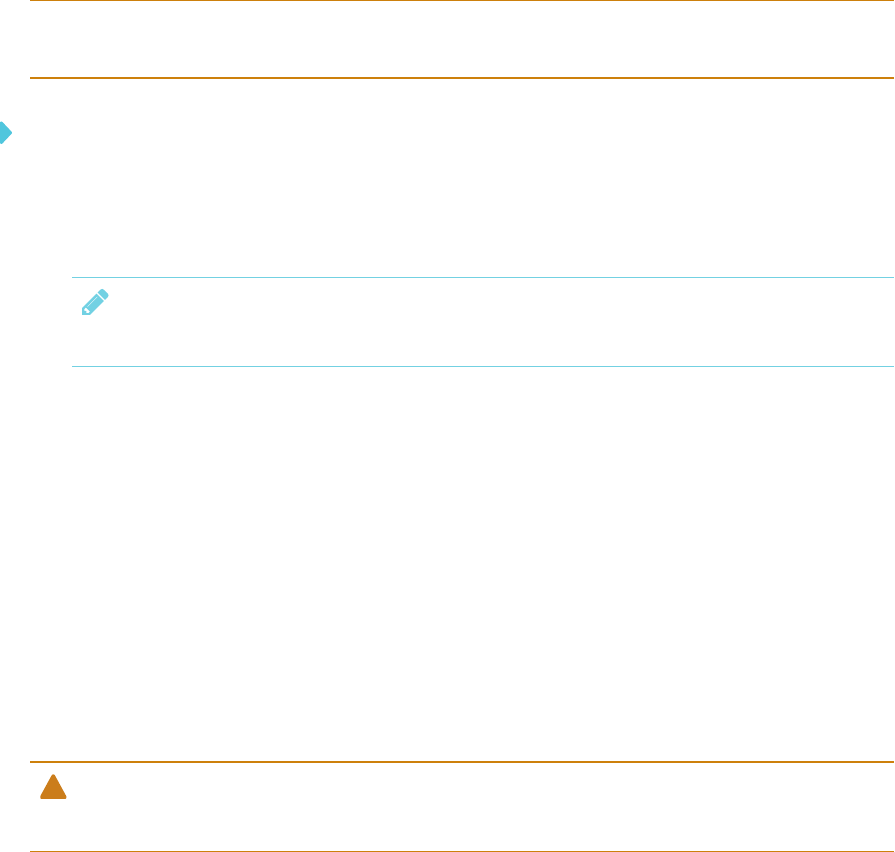
CHAPTER 6
MAINTAINING THE DISPLAY
42 smarttech.com/kb/171164
lDo not use cleaning solutions or glass cleaners on the screen, because they can deteriorate
or discolor the screen.
To clean the screen
1. Press the Freeze button on the convenience panel to temporarily freeze the screen (see
Convenience panel on page6).
2. Wipe the screen with a lint-free, non-abrasive cloth.
NOTE
Alternatively, you can use a damp cloth with a drop of dish soap.
3. Press the Freeze button on the convenience panel to unfreeze the screen.
Maintaining ventilation
The display requires proper ventilation. Dust buildup in the ventilation holes compromises cooling
and can lead to product failure.
lClean accessible ventilation holes monthly with a dry cloth.
lUse a vacuum cleaner with a narrow hose end fitting to clear the back ventilation holes
regularly. You might have to remove the display from the wall. For more information on
removing the display, see Removing and transporting the display on page44.
CAUTION
Avoid setting up or using the display in an area with excessive levels of dust, humidity or smoke.
Preventing condensation
The screen contains layers of glass that can collect condensation, especially in the following
conditions:
lTemperature extremes with high humidity
lRapid changes in humidity, which can occur when you operate the product near water (such as
a pool, kettle or air conditioner ventilator)

CHAPTER 6
MAINTAINING THE DISPLAY
43 smarttech.com/kb/171164
To evaporate condensation from the display
1. Remove the humidity source from the display, if possible.
2. Turn off the display.
3. Remove any moisture from the display with a smooth, dry cloth.
4. If the display has been moved from a colder environment to a warmer environment (for
example, from storage to the installation site), leave the display turned on for 48 hours.
Otherwise, leave the display turned off for 48 hours.
Replacing the pens and eraser
To prevent damage to the display’s anti-glare coating, replace a pen if its nib or eraser pad
become worn. You can purchase replacement pens and erasers from the Store for SMART Parts
(seesmarttech.com/Support/PartsStore).
Turning the display off and back on
In some situations, you need to turn off the display for a period of time. You can turn it back on
after.
To turn the display off
1. Press the Power button on the convenience panel for four seconds.
A slider appears on the screen.
2. Move the slider to the right.
3. Flick the switch beside the AC power inlet to the OFF(O) position.
NOTE
Wait at least 30 seconds before turning the display back on.
To turn the display back on
Flick the switch beside the AC power inlet to the ON(I) position.
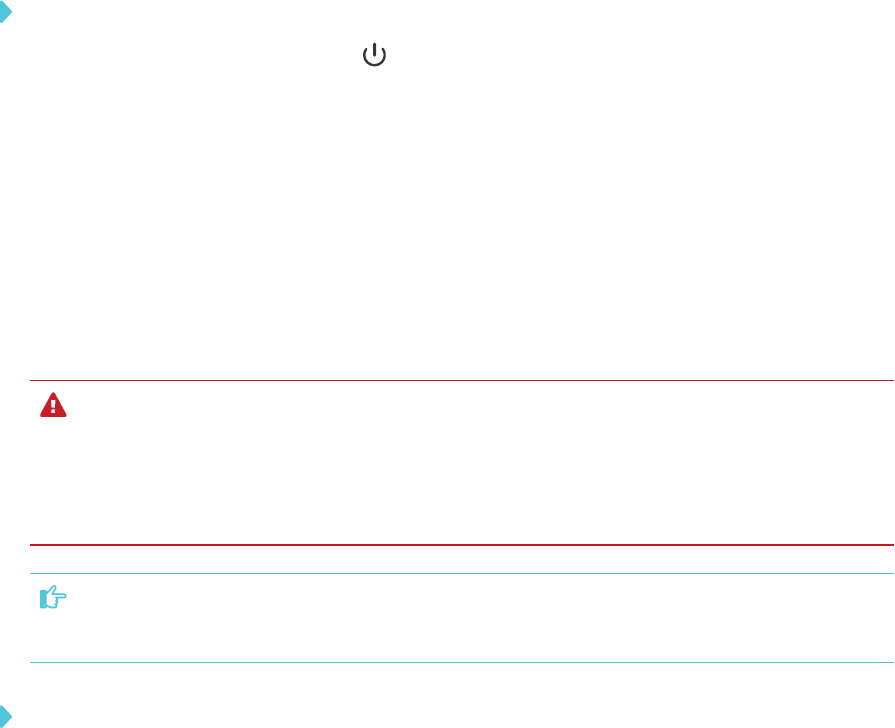
CHAPTER 6
MAINTAINING THE DISPLAY
44 smarttech.com/kb/171164
Resetting the display
You can reset the display and the iQ appliance using the convenience panel.
To reset the display
Press and hold the Power button on the convenience panel for 10 seconds.
The display and iQ appliance reset.
Removing and transporting the display
If the display is wall mounted, you might need to remove it from its current location and transport it
to another location on occasion.
To remove the display safely, use two or more trained installers.
WARNING
lDo not attempt to move the display by yourself. The display is very heavy.
lDo not move the display by connecting a rope or wire to the handles on the back. The
display can fall and cause injury and product damage.
IMPORTANT
Follow any documentation included with the third-party mounting hardware.
To remove the display
1. Turn off any connected computers.
2. Turn off the display (see Turning the display off and back on on the previous page).
3. Remove all accessible cables and connectors.
4. Remove the iQ appliance from the accessory slot.

CHAPTER 6
MAINTAINING THE DISPLAY
45 smarttech.com/kb/171164
5. Lift the display from its mounting location.
WARNING
Do not place the display on a sloping or unstable cart, stand or table. The display could fall,
resulting in injury and severe product damage.
CAUTION
Do not leave the display face up, face down or upside down for an extended period. This
could cause permanent damage to the screen.
6. Remove the mounting brackets.
To transport the display
See Transporting the display on page11.

Chapter 7
47 smarttech.com/kb/171164
Chapter 7: Troubleshooting
Troubleshooting the display 47
Resolving issues with power 48
Resolving issues with video 48
Resolving issues with audio 49
Resolving issues with touch and digital ink 49
Troubleshooting the display’s software 50
Resolving general issues 50
Resolving issues with Activities 51
Resolving issues with Workspaces 51
Resolving issues with SMARTNotebook Player 51
Resolving issues with Browser 52
Resolving issues with Input 52
Resolving issues with Screen Share 53
Resolving issues with Android mobile devices 53
Resolving issues with Apple devices 55
Resolving issues with Chrome browser and Chromebook 57
Resolving issues with Windows computers 58
Advanced troubleshooting for Screen Share 59
Referring to the SMART knowledge base for additional troubleshooting information 60
Contacting your reseller for additional support 61
Locating the display serial number 61
Locating the iQ appliance serial number 61
This chapter explains how to troubleshoot issues with the display and its software.
Troubleshooting the display
The following information helps you resolve a variety of common issues with the display, including
issues with:
lPower
lVideo
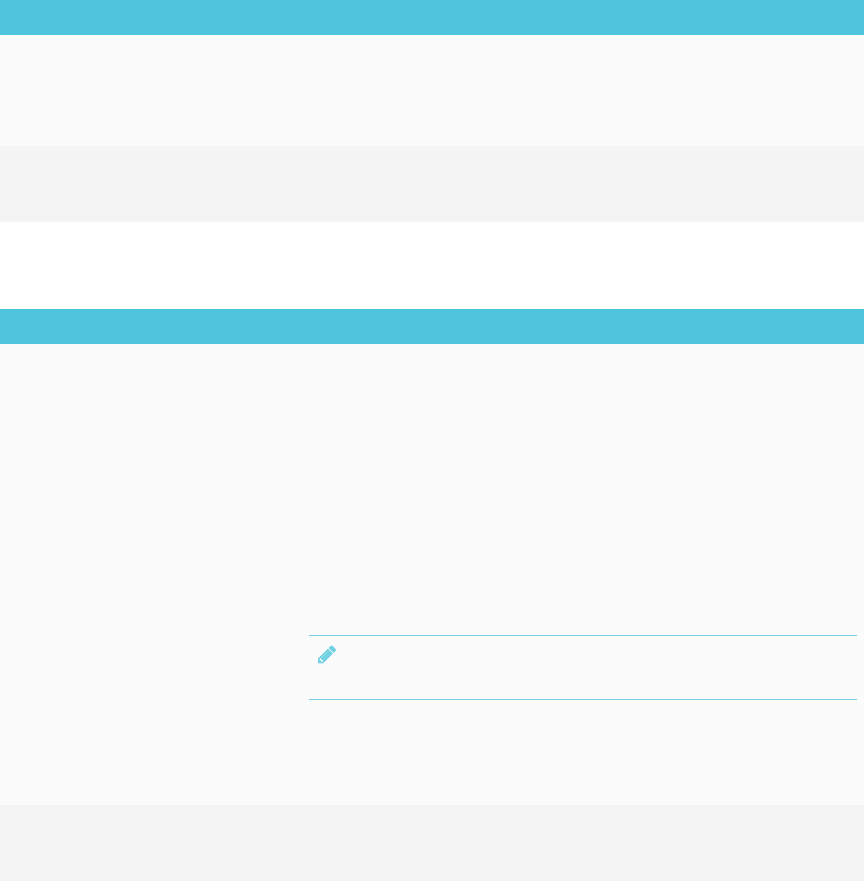
CHAPTER 7
TROUBLESHOOTING
48 smarttech.com/kb/171164
lAudio
lTouch and digital ink
Resolving issues with power
Issue Solutions
The display doesn’t turn on and its
indicator light isn’t on.
lMake sure the power cable is properly connected to the wall and display.
lMake sure the switch beside the AC power inlet is in the ON (I) position.
lMake sure the power outlet is working by testing it with a different device.
lMake sure the power cable is working by testing it with a different device.
The display turns on, its status lights
turn on, but nothing shows on the
screen.
See Resolving issues with video below.
Resolving issues with video
Issue Solutions
You’re experiencing the following
or similar issues with video:
lA computer is connected to
the display, but only “Looking
for a connection” appears on
the screen.
lThe image on the screen is
flickering, flashing or lines,
double images, snow or
other distortions are
appearing.
lThe image is cut off or shifted
to the left or right.
lThe image doesn’t fill the
entire screen.
lMake sure the computer is connected to the display with only a single cable.
lMake sure the video cable connecting the display and the computer meets
SMART’s recommendations.
See Connecting cables for room computers, guestlaptops and other input
sources on page21.
lMake sure the cables connecting the display to the computer are securely
fastened.
lSet the computer’s resolution and refresh rate to values supported by the
display.
See Setting connected computers’ resolutions and refresh rates on page40.
lMake sure the video cable and computer are working by testing them with a
different display.
NOTE
Test the video cable and the computer separately to isolate issues.
lMake sure the display connectors are working by testing them with a different
computer or other input source.
lRestart the display.
See Turning the display off and back on on page43.
You’re experiencing other issues
with video or the solutions above
don’t resolve the issue.
lSee Referring to the SMART knowledge base for additional troubleshooting
information on page60.

CHAPTER 7
TROUBLESHOOTING
49 smarttech.com/kb/171164
Resolving issues with audio
Issue Solutions
You’re experiencing the following
or similar issues with audio:
lNo sound is coming from the
speakers.
lSound is coming from the
speakers, but the volume is
low.
lThe sound is distorted or
muffled.
lMake sure the display and the connected computer aren’t muted.
See Convenience panel on page6.
lMake sure the display’s sound settings are correct.
See Appendix A: Using settings on page63.
lBe aware that the stereo 3.5 mm in connector only works with the VGA input.
See Connecting cables for room computers, guestlaptops and other input
sources on page21.
lIf you’re using the integrated speakers, set the volume for the computer and any
running applications to 80%, and then adjust the display’s volume.
OR
If you’re using external speakers, set the volume for the computer, any running
applications and the display to 80%, and then adjust the speakers’ volume.
See Convenience panel on page6.
lIf you’re using external speakers, use different cables to verify if the issue is with
the cables.
You’re experiencing other issues
with audio or the solutions above
don’t resolve the issue.
lSee Referring to the SMART knowledge base for additional troubleshooting
information on page60.
Resolving issues with touch and digital ink
Issue Solutions
You’re experiencing the following
or similar issues with touch and
digital ink:
lThe display doesn’t respond
to touch.
lDigital ink doesn’t appear
when users write on the
screen.
lUnwanted digital ink is
appearing on the screen.
lWhen users touch or write on
the screen, the pointer or
digital ink appears in the
wrong place.
lBe aware that users can’t touch or write or draw over content shared with the
Screen Share app.
lClean the display.
See Cleaning the display on page41.
lMake sure SMART Product Drivers and SMARTInk are installed and running on
the computer.
See Installing SMART software on connected computers on page39
lInstall the latest firmware.
See Chapter 6: Maintaining the display on page41.
lMake sure the computer is connected to the display with only a single cable.
lMake sure the cables connecting the display to the computer are securely
fastened.
lRestart the computer.
lRestart the display.
See Turning the display off and back on on page43.
You’re experiencing other issues
with touch and digital ink or the
solutions above don’t resolve the
issue.
lSee Referring to the SMART knowledge base for additional troubleshooting
information on page60.

CHAPTER 7
TROUBLESHOOTING
50 smarttech.com/kb/171164
Troubleshooting the display’s software
This section explains how to troubleshoot the display’s software.
Resolving general issues
Issue Solutions
An app or feature is missing or not
available.
lThe apps and features available depend on the iQ appliance model.
See Identifying your SMARTkappiQ® system and AM30 appliance version.
lThe iQ system software may not include that feature or app.
See the iQ system software release notes.
lThe app may be disabled.
See Appendix A: Using settings on page63.
The iQ apps and features do not
appear when the display is turned
on.
lWait for a minute after first turning on the display or switching the input source to
the iQ appliance. This delay may be longer immediately after upgrading the iQ
system software.
lThe iQ appliance has stopped responding during startup or after a system
software update. Turn off the display, unplug the power cable and wait at least
30 seconds before reconnecting the power cable and turning on the display.
There is no content from the HDMI
video out connector.
The connected HDMI sync device (for example, a display, video splitter, video
extender or video capture system) may not support High-Bandwidth Digital
Content Protection (HDCP).
Make sure the sync device is able to receive and display HDMI content that is
protected by HDCP. For more information, see SMART Board interactive flat
panels and High-bandwidth Digital Content Protection (HDCP).
When updating the iQ system
software with a USB drive, the
update process doesn’t start.
lThe iQ system software version already installed may be newer than or the
same version as the version on the USB drive.
Compare the version number of the current iQ system software with the version
number of the upgrade file on the USB drive.
lFollow the installation instructions provided on SMART’s website when updating
the iQ system software.
TIPS
oMake sure the USB drive is FATformatted.
oMake sure the file has not been renamed or unzipped. The file should
be copied to the USB drive unmodified.
oMake sure the file is located in the root folder on the USB drive.
oMake sure the USB drive is inserted in the convenience panel on the
display’s frame.
oAfter inserting the USB drive in the convenience panel, switch to the
Whiteboard app.

CHAPTER 7
TROUBLESHOOTING
51 smarttech.com/kb/171164
Resolving issues with Activities
Issue Solutions
There is an issue with Activities. lMake sure the display is connected to a network.
See Connecting to a network on page30.
lIf Activities can’t visit secure (https) websites, make sure the display’s date and
time are correct.
See Date & time on page68.
lMake sure the network firewall isn’t blocking services required for Activities.
See Configuring the network for the display on page30.
lContact your system administrator.
Resolving issues with Workspaces
Issue Solutions
Workspaces is unable to display
any content.
lMake sure the display is connected to a network.
See Connecting to a network on page30.
lIf Workspaces can’t visit secure (https) websites, make sure the display’s date
and time are correct.
See Date & time on page68.
lMake sure the network firewall isn’t blocking services required for Workspaces.
See Configuring the network for the display on page30.
lContact your system administrator.
Resolving issues with SMARTNotebook Player
Issue Solutions
The display’s name doesn’t appear
in the list of available devices.
Make sure the display and computer are set to the correct date and time.
See Date & time on page68 and your computer’s documentation.
I’m unable to download
SMARTNotebook Player.
lIf you’re using an iPhone, download the app from the Apple AppStore.
lNotebook Player is currently unavailable for Android devices and iPad devices.
I’m unable to sign in to Notebook
Player.
Use your Google or Microsoft account to sign in.
There are no SMARTNotebook
files in the mobile app.
You need to share a SMARTNotebook file with the display.
See the SMARTBoard 7000 series interactive displays user’s guide
(smarttech.com/kb/171163) and your computer’s documentation.
The mobile device or Notebook
Player is no longer connected to the
display.
The display or the mobile device is unable to connect to the Internet. Checkthe
settings for display and the mobile device and try connecting again.

CHAPTER 7
TROUBLESHOOTING
52 smarttech.com/kb/171164
Resolving issues with Browser
Issue Solutions
There is an issue with Browser. lMake sure the display is connected to a network.
See Connecting to a network on page30.
lIf Browser can’t visit secure (https) websites, ensure the display’s date and time
are correct.
See Date & time on page68.
lContact your system administrator.
Resolving issues with Input
Issue Solutions
There is an issue with the image. lSee Resolving issues with video on page48 for more information.
lConnect the computer to the display’s connectors. See <XREF>.
lIf you’re using two connected video cables, use one longer cable or move the
computer so it’s within a single cable length of the iQ appliance.
lThe computer’s video resolution settings and refresh rates aren’t supported by
the display. The display supports the following resolutions and refresh rates:
o1920 × 1080 at 6 0 Hz
o1280 × 720 at 60 Hz
There is an issue with touch. lMake sure the USB cable is securely fastened to both your computer and the
display.
lUse a USB 2.0 cable and make sure it’s connected to the correct USB
receptacle.
See Connecting cables for room computers, guestlaptops and other input
sources on page21.
lIf touch interactivity is slow, close some open applications on the computer.
lMake sure the latest version of SMART Product Drivers is installed on your
computer.
See smarttech.com/downloads.
lRemove any USB cable extenders. For best results, use a 16' (5 m) or shorter
USB cable.
There is an issue with audio. lSee Resolving issues with audio on page49.
lTurn off the mute setting on your computer.
lTurn up the volume on your computer.
lTurn up the volume on the display.
See Convenience panel on page6.

CHAPTER 7
TROUBLESHOOTING
53 smarttech.com/kb/171164
Resolving issues with Screen Share
TIP
Restart the Screen Share app and its discovery services:
1. On the display, open the launcher.
The launcher appears.
2. Tap Settings .
3. Scroll to Applications > Screen Share.
4. Tap Reset.
Resolving issues with Android™ mobile devices
Issue Solutions
The display’s name doesn’t appear
in the list of available devices.
lMake sure your mobile device is on the same network as the display.
lNot all Android devices can initiate Screen Share from the notification drawer.
Download the Google Home app from Google Play™ to use Screen Share.
lIf your display is using a wired network connection, try connecting it to a wireless
network.
NOTE
Wired and wireless networks don’t often share the same network subnet.
Connecting the display to a wireless network might help the connection
between the display and a mobile device or computer that’s connected
wirelessly.
lMake sure the display and mobile device are set to the correct date and time.
See Date & time on page68 and your mobile device’s documentation.
lOn your mobile device, turn Airplane mode on and then off again.
lRestart your Android mobile device.
NOTE
Restarting your mobile device can clear network address information that
your mobile device had cached. Restarting the mobile device can also
reinitialize audio and video encoders that might have stopped working
properly.
lRestart your display.
See Turning the display off and back on on page43.
lIf you’ve restarted your display and still don’t see the display’s name in the list of
devices, wait several minutes and then try to connect to the display again.
lEnsure you have the latest operating software on your Android mobile device.
Make sure no system updates are pending for your Android mobile device. See
the mobile device’s user guide for more information.

CHAPTER 7
TROUBLESHOOTING
54 smarttech.com/kb/171164
Issue Solutions
The display’s name appears in the
list of available devices but you’re
unable to connect to it.
lOpen the Screen Share app.
a. On the display, open the launcher.
The launcher appears.
b. Tap Screen Share .
The video is choppy or the audio
isn’t in sync with the video.
lIf your network is slow or congested, Screen Share is affected. Contact your
administrator.
lYour mobile device could be connected to different access points than your
display, which can increase latency. Turn Airplane mode on and then off on your
mobile device to try to connect to a closer access point.
lMake sure the antenna is attached to the iQ appliance.
lSharing videos or playing video games with frequent screen updates requires
more network bandwidth. Try reducing the video quality to improve
performance.
See Evaluating the impact of Screen Share on your network data usage on
page34.
lYour mobile device may not be optimized for sharing its screen and is limited to
lower quality performance. Try connecting with a different mobile device.
lEnsure you have the latest operating software on your Android mobile device.
Make sure no system updates are pending for your Android mobile device. See
the mobile device’s user guide for more information.
The video has no audio. lMake sure the volume on your mobile device is turned up and the display is not
muted.
lTurn up the volume on the display.
See Convenience panel on page6.
lMake sure you have the latest operating software on your Android mobile
device.
lRestart your mobile device.
The screen is not responding to
touch or you’re unable to write or
draw with the pens.
Touch interactions are not supported while using Screen Share.
The issues persist even after you’ve
restarted your Android mobile
device and ensured it is on the
same network as the display.
Contact your system administrator.
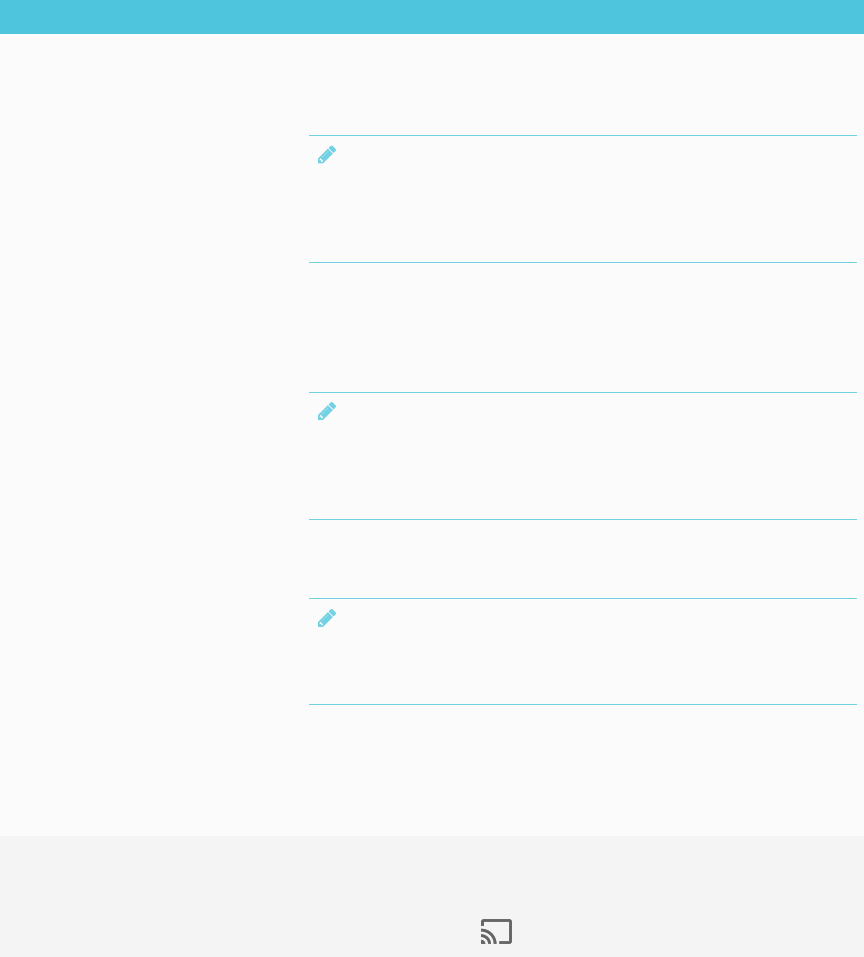
CHAPTER 7
TROUBLESHOOTING
55 smarttech.com/kb/171164
Resolving issues with Apple devices
Issue Solutions
The display’s name doesn’t appear
in the list of available devices.
lMake sure your mobile device or computer is on the same network as the
display.
lIf your display is using a wired network connection, try connecting it to a wireless
network.
NOTE
Wired and wireless networks don’t often share the same network subnet.
Connecting the display to a wireless network might help the connection
between the display and a mobile device or computer that’s connected
wirelessly.
lMake sure the display and computer are set to the correct date and time.
See Date & time on page68 and your computer’s documentation.
lOn your mobile device, turn Airplane mode on and then off on your mobile
device.
lRestart your mobile device.
NOTE
Restarting your mobile device can clear network address information that
your mobile device had cached. Restarting the mobile device can also
reinitialize audio and video encoders that might have stopped working
properly.
lOn your computer, turn Wi-Fi off and then back on, or disconnect and then
reconnect the Ethernet cable.
lRestart your computer.
NOTE
Restarting your computer can clear network address information that your
computer had cached. Restarting the computer can also reinitialize audio and
video econders that might have stopped working properly.
lRestart your display.
See Turning the display off and back on on page43.
lIf you’ve restarted your display and still don’t see the display’s name in the list of
devices, wait several minutes and then try to connect to the display again.
lMake sure your computer or device has the latest operating system software.
The display’s name appears in the
list of available devices but you’re
unable to connect to it.
Open the Screen Share app.
a. On the display, open the launcher.
The launcher appears.
b. Tap Screen Share .

CHAPTER 7
TROUBLESHOOTING
56 smarttech.com/kb/171164
Issue Solutions
The video is choppy or the audio
isn’t in sync with the video.
lIf your network is slow or congested, Screen Share is affected. Contact your
administrator.
lThe display and the mobile device or computer could be connected to different
wireless access points, which can increase latency. On the mobile device, turn
Airplane mode on and back off to try to connect to a closer access point. On the
computer, disconnect and then reconnect the Ethernet cable or turn Wi-Fi off
and then back on to try to connect to a closer access point.
lMake sure the antenna is attached to the iQ appliance.
lReduce your computer’s display resolution to 1920 × 1080 or lower.
lSharing videos or playing video games with frequent screen updates requires
more network bandwidth. Try reducing the video quality to improve
performance.
See Evaluating the impact of Screen Share on your network data usage on
page34.
lMake sure your computer or device has the latest operating system software.
The video has no audio. lMake sure the volume on your iOS device is turned up and the display is not
muted.
lMake sure the Ring/Silent switch isn’t set to silent on your mobile device.
lTurn up the volume on the display.
See Convenience panel on page6.
The screen is not responding to
touch or you’re unable to write or
draw with the pens.
Touch interactions are not supported while using Screen Share.
The issues persist even after you’ve
restarted your Mac computer or
iOS mobile device and ensured
they are on the same network as
the display.
Contact your system administrator.
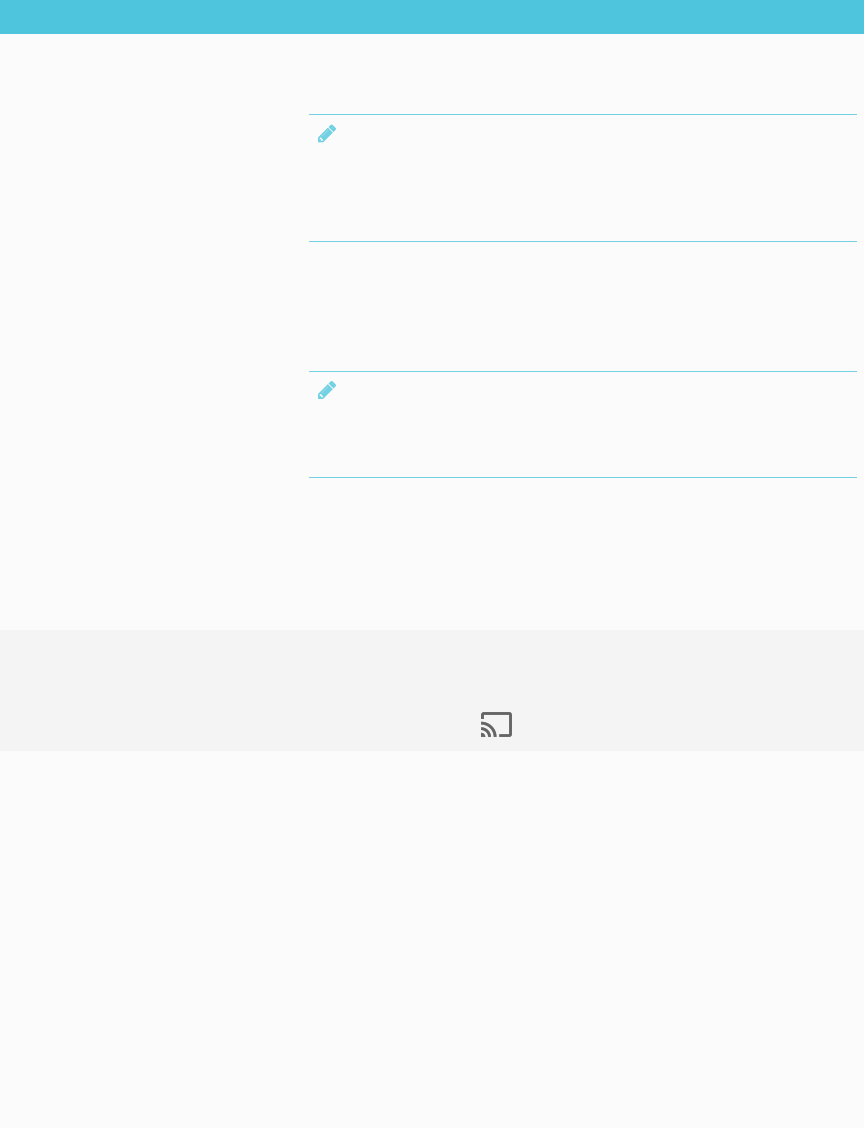
CHAPTER 7
TROUBLESHOOTING
57 smarttech.com/kb/171164
Resolving issues with Chrome™ browser and Chromebook™
Issue Solutions
The display’s name doesn’t appear
in the list of available devices.
lMake sure your computer is on the same network as the display.
lIf your display is using a wired network connection, try connecting it to a wireless
network.
NOTE
Wired and wireless networks don’t often share the same network subnet.
Connecting the display to a wireless network might help the connection
between the display and a mobile device or computer that’s connected
wirelessly.
lMake sure the display and computer are set to the correct date and time.
See Date & time on page68 and your computer’s documentation.
lOn your computer, turn Wi-Fi off and then back on, or disconnect and then
reconnect the Ethernet cable.
lRestart your computer.
NOTE
Restarting your computer can clear network address information that your
computer had cached. Restarting the computer can also reinitialize audio and
video encoders that might have stopped working properly.
lFor more information about the Google Cast browser extension, see Casting a
tab or entire desktop.
lRestart your display.
See Turning the display off and back on on page43.
lIf you’ve restarted your display and still don’t see the display’s name in the list of
devices, wait several minutes and try to connect to the display again.
The display’s name appears in the
list of available devices but you’re
unable to connect to it.
Open the Screen Share app.
a. On the display, open the launcher.
The launcher appears.
b. Tap Screen Share .
The video is choppy or the audio
isn’t in sync with the video.
lIf your network is slow or congested, Screen Share is affected. Contact your
administrator.
lNot all devices are designed for video encoding for Screen Sharing, so video
streaming might not behave as expected.
lSharing videos or playing video games with frequent screen updates requires
more network bandwidth. Try reducing the video quality to improve
performance.
See Evaluating the impact of Screen Share on your network data usage on
page34.
lScreen Share has not been optimized for performance with Chromebooks. For
best results, limit usage to static content.
lThe display and the computer might be connected to different wireless access
points, which can increase latency. On the computer, disconnect and then
reconnect the Ethernet cable or turn Wi-Fi off and then back on to try to connect
to a closer access point.
lMake sure the antenna is attached to the iQ appliance.
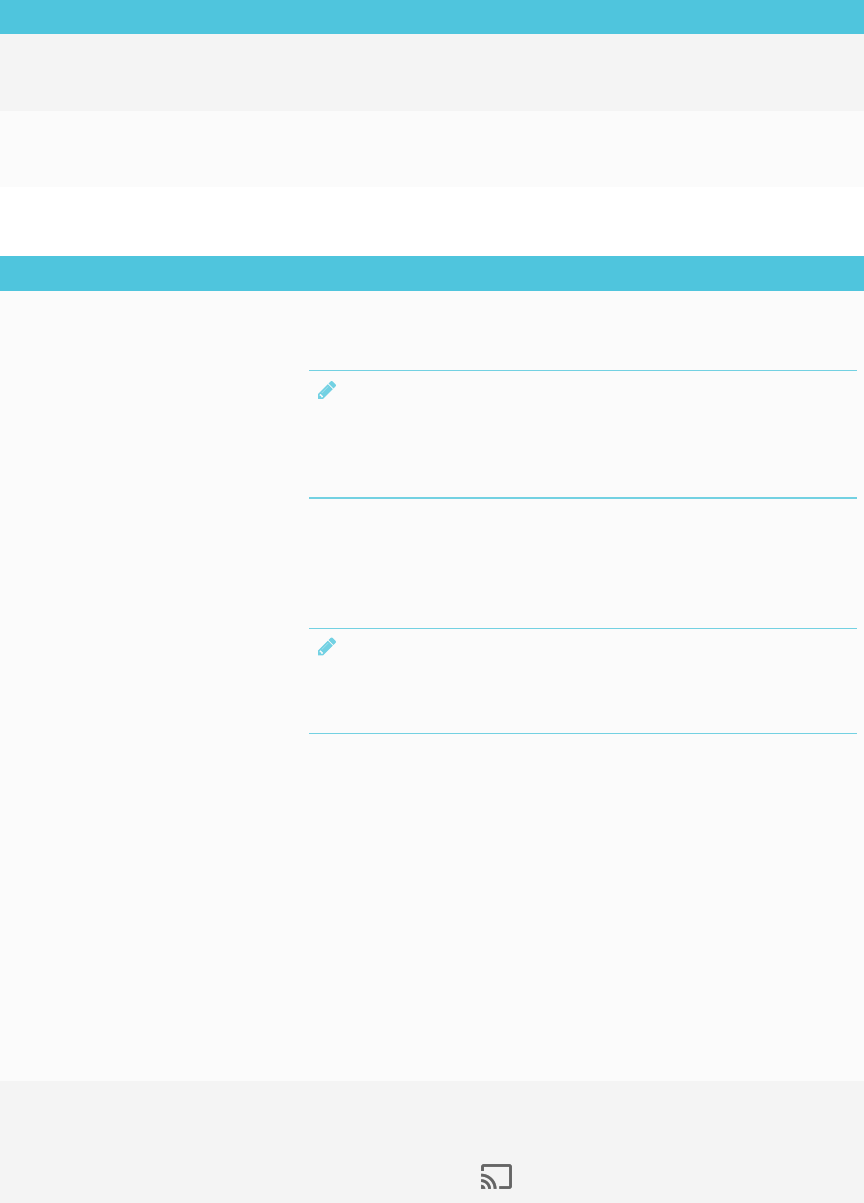
CHAPTER 7
TROUBLESHOOTING
58 smarttech.com/kb/171164
Issue Solutions
Parts of the image do not display
correctly when sharing streaming
video to the display.
If sharing content from a Chrome browser tab, share the entire desktop. See the
SMARTBoard 7000 series interactive displays user’s guide
(smarttech.com/kb/171163) for more information.
The screen is not responding to
touch or you’re unable to write or
draw with the pens.
Touch interactions are not supported while using Screen Share.
Resolving issues with Windows® computers
Issue Solutions
The display’s name doesn’t appear
in the list of available devices.
lMake sure your computer is on the same network as the display.
lIf your display is using a wired network connection, try connecting it to a wireless
network.
NOTE
Wired and wireless networks don’t often share the same network subnet.
Connecting the display to a wireless network might help the connection
between the display and a mobile device or computer that’s connected
wirelessly.
lMake sure the display and computer are set to the correct date and time.
See Date & time on page68 and your computer’s documentation.
lOn your computer, turn Wi-Fi off and then back on, or disconnect and then
reconnect the Ethernet cable.
lRestart your computer.
NOTE
Restarting your computer can clear network address information that your
computer had cached. Restarting the computer can also reinitialize audio and
video encoders that might have stopped working properly.
lRestart your display.
See Turning the display off and back on on page43.
lIf you’ve restarted your display and still don’t see the display’s name in the list of
devices, wait several minutes and try to connect to the display again.
lMake sure the operating system on your computer is up to date.
lWindows Wireless Display (Miracast) is currently not supported.
oUse Google Cast from Chrome browser.
See the SMARTBoard 7000 series interactive displays user’s guide
(smarttech.com/kb/171163).
oYou can purchase AirParrot, an application that allows you to share your
computer’s display, an application, audio or a media file.
See AirParrot.
lIf you’ve restarted your display and still don’t see the display’s name in the list of
devices, wait several minutes and then try to connect to the display again.
The display’s name appears in the
list of available devices but you’re
unable to connect to it.
Open the Screen Share app.
a. On the display, open the launcher.
The launcher appears.
b. Tap Screen Share .

CHAPTER 7
TROUBLESHOOTING
59 smarttech.com/kb/171164
Issue Solutions
The video is choppy or the audio
isn’t in sync with the video.
lIf your network is slow or congested, Screen Share is affected. Contact your
administrator.
lThe Wi-Fi signal could be weak. Contact your administrator.
lYour device could be connected to a different access point than your display,
which can increase latency. Turn Airplane mode on and then off on your
computer to try to connecting to a closer access point.
lSharing videos or playing video games with frequent screen updates requires
more network bandwidth. Try reducing the video quality to improve
performance.
See Evaluating the impact of Screen Share on your network data usage on
page34.
lMake sure the antenna is attached to the iQ appliance.
lReduce your display’s resolution to 1920 × 1080 or lower.
lMake sure the operating system on your computer is up to date.
lIf you’re using AirParrot, make sure AirParrot is up to date.
lIf you’re using Chrome, the browser is version 52 or later and is up to date.
lIf you’ve restarted your display and still don’t see the display’s name in the list of
devices, wait several minutes and then try to connect to the display again.
Which version of Chrome browser
supports Screen Share?
Chrome browser version 52 or later
The screen is not responding to
touch or you’re unable to write or
draw with the pens.
Touch interactions are not supported while using Screen Share.
Advanced troubleshooting for Screen Share
Issue Solutions
Mobile devices and computers can’t find
the display.
lSchool networks often block a number of network ports.
Ask the administrator to allow
oTCPports 7000, 8008, 8009, 47000, 7100, 49228, 50259
oUDP ports 62572 and 54780
oIf using Google Cast, UDP port 1900
oIf using Windows computer or a Mac computer, UDP port 5353.
See To allow mobile devices and computers to use AirPlay and Google Cast
to use the Screen Share app on page32 for more information.
lThe display’s casting ID may not have propagated yet through the network
or may be cached on the network when it’s not actually available.
Wait several minutes and attempt to connect again.
lYou’re using Miracast or an unsupported wireless screen casting method.
See the SMARTBoard 7000 series interactive displays user’s guide
(smarttech.com/kb/171163).

CHAPTER 7
TROUBLESHOOTING
60 smarttech.com/kb/171164
Issue Solutions
Screen Share is not working for
Windows computers.
lThere might be an issue with the Windows firewall.
oWindows 7 operating system: See Allow a program to communicate
through Windows Firewall.
oWindows 8 operating system: See Windows Firewall from start to
finish.
lYour antivirus product might be blocking access. See the antivirus product’s
help for more information.
Screen Share is not working for Mac
computers.
lThere might be an issue with the Mac firewall. See OSX: About the
application firewall.
lYour antivirus product might be blocking access. See the antivirus product’s
help for more information.
lThe network must be configured to run Bonjour and mDNS, and Multicast
must be enabled.
lEnsure your device and display are on the same VLAN or subnet.
AirPlay is not displaying on an iOS
mobile device.
lEnsure the iOS device is on the same network as the display.
lTry connecting the display with a wired network connection.
lSee Get help with AirPlay and AirPlay Mirroring on your iPhone, iPad, or iPod
touch.
Screen Share is not working on Android
devices.
lEnsure your Android mobile device is on the same network as the display.
lCasting the screen is available on mobile devices running Android 4.4.2 or
later.
lTurn off the device’s Power Saving mode.
lIf you’ve downloaded the Google Cast app, see Cast your Android screen
from the Chrome Cast app.
lYour antivirus product might be blocking access. See the antivirus product’s
help for more information.
lYour network consists of multiple access points connected to a single
wireless LAN controller (WLC).
oSee Chrome Cast Deployment Guide, Release 7.6.
oSee Chrome Cast mDNS Service in order to Cast Screen
Configuration on WLC.
Screen Share app closes unexpectedly
or the video stops playing on the display.
lIf your display is connected to a 2.4 GHz network, connect your display to a
5 GHz network.
lSelect a less congested Wi-Fi channel.
Referring to the SMART knowledge base for
additional troubleshooting information
Refer to the SMART knowledge base for additional troubleshooting information not include in this
guide:
community.smarttech.com

CHAPTER 7
TROUBLESHOOTING
61 smarttech.com/kb/171164
Contacting your reseller for additional support
If an issue you’re experiencing with the display persists or isn’t covered in this guide or the
knowledge base, contact your authorized SMART reseller (smarttech.com/where).
Your reseller might ask you for the serial number for the display or the iQ appliance.
Locating the display serial number
The display’s serial number is located in three places:
lIn the iQ settings (see Appendix A: Using settings on page63)
lOn the bottom frame
lOn the back of the display
Locating the iQ appliance serial number
The iQ appliance’s serial number is located in two places:
lIn the iQ settings (see Serial number on page64)
lOn the iQ appliance
NOTE
You need to remove the iQ appliance from the display to locate the serial number.

Appendix A
63 smarttech.com/kb/171164
Appendix A: Using settings
About device 63
Diagnostics 64
Language 64
Country 65
Security 65
Wi-Fi 66
Advanced Wi-Fi options 67
Ethernet 67
Date & time 68
Usage Data 68
Auto Update 69
Display 69
Audio 69
Launcher 70
SMARTiQ Whiteboard 70
Screen Share 71
You can access the display’s settings using the icon in the launcher.
About device
Option Values Function Notes
Product information
Board name [N/A] Select a name for your
display
[N/A]
Help [N/A] Shows the SMART support
site for the display
[N/A]
Send Feedback [N/A] Send feedback to SMART
about the display
experience
[N/A]

APPENDIX A
USING SETTINGS
64 smarttech.com/kb/171164
Option Values Function Notes
Legal Information [N/A] Shows the open source
licenses, the SMART end
user license agreement
and SMART intellectual
property information
[N/A]
Board information
Build number [N/A] Shows the iQ system
software’s version number
[N/A]
Touch controller
version
[N/A] N/A [N/A]
Scaler version [N/A] N/A [N/A]
Serial number [N/A] Shows the iQ appliance’s
serial number
[N/A]
Bluetooth address [N/A] Shows the display’s
Bluetooth address
[N/A]
Up time [N/A] Shows how long the
display has been turned on
Turning off the display resets
the up time to 0.
Board configuration
Factory data reset [N/A] Resets all options to their
default values
Only administrators should
reset the display.
Diagnostics
Option Values Function Notes
Write logs to USB [N/A] Copy diagnostic logs to a USB drive [N/A]
Input
Show touches [N/A] Shows visual feedback of touches
on the screen
[N/A]
Pointer location [N/A] Shows touch feedback [N/A]
Language
Option Values Function Notes
Language [Languages] Sets the language for the settings
menu
To select a different language for
the on-screen display menu, see
<XREF>.

APPENDIX A
USING SETTINGS
65 smarttech.com/kb/171164
Country
Option Values Function Notes
Country [Countries] Sets the display’s country [N/A]
Security
Option Values Function Notes
Clean up
Clean up policy Disabled
Manually reset
with the Clean
Up button in the
launcher
1 hour
2 hours
3 hours
1 day
Sets how often the display cleans
up
[N/A]
Clean up the
whiteboard
[N/A] Saves the Whiteboard session to
the Library and erases the
Whiteboard
[N/A]
Clean up the browser [N/A] Closes the browser tabs and clears
the history, cache and cookies
[N/A]
Clean up other
applications
[N/A] Closes open applications [N/A]
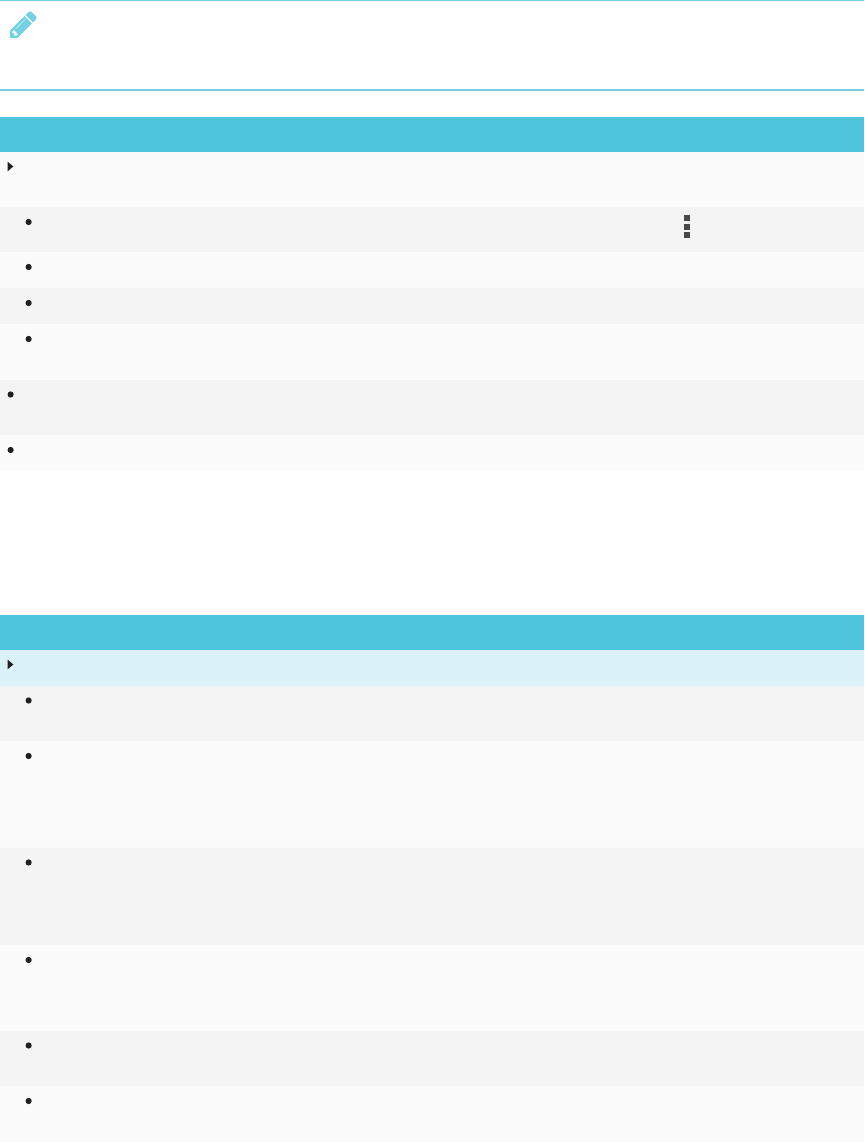
APPENDIX A
USING SETTINGS
66 smarttech.com/kb/171164
Wi-Fi
NOTE
To add a proxy, see Connecting the display to a network on page33.
Option Values Function Notes
Wi-Fi [Wireless
networks]
Select a wireless network Turn on Wi-Fi to discover networks.
Scan [N/A] Scan for wireless networks Tap More to access this option.
WPS Pin Entry [N/A] [N/A] Not used
Wi-Fi Direct [N/A] [N/A] Not used
Advanced [N/A] Set advanced options for Wi-Fi See Advanced Wi-Fi options on the
facing page.
WPSpush button [N/A] Connect to a wireless network
using Wi-Fi Protected Setup
[N/A]
Add network [N/A] Add a wireless network [N/A]
Advanced Wi-Fi options
Option Values Function Notes
Advanced
Network notification [N/A] Notifies you when an open wireless
network is available
[N/A]
Keep Wi-Fi on during
sleep
Always
Only when
plugged in
Never
Determines if the Wi-Fi remains on
when the display goes to sleep
[N/A]
Scanning always
available
[N/A] Allow Google’s location service and
other applications to scan for
networks, even when Wi-Fi is
turned off
[N/A]
Wi-Fi frequency band Auto
5 Ghz
2.4 Ghz
Wi-Fi frequency band [N/A]
Install certificates [N/A] Install certificates to connect to a
network
[N/A]
Wi-Fi optimization [N/A] Minimize battery usage when Wi-Fi
is enabled
[N/A]
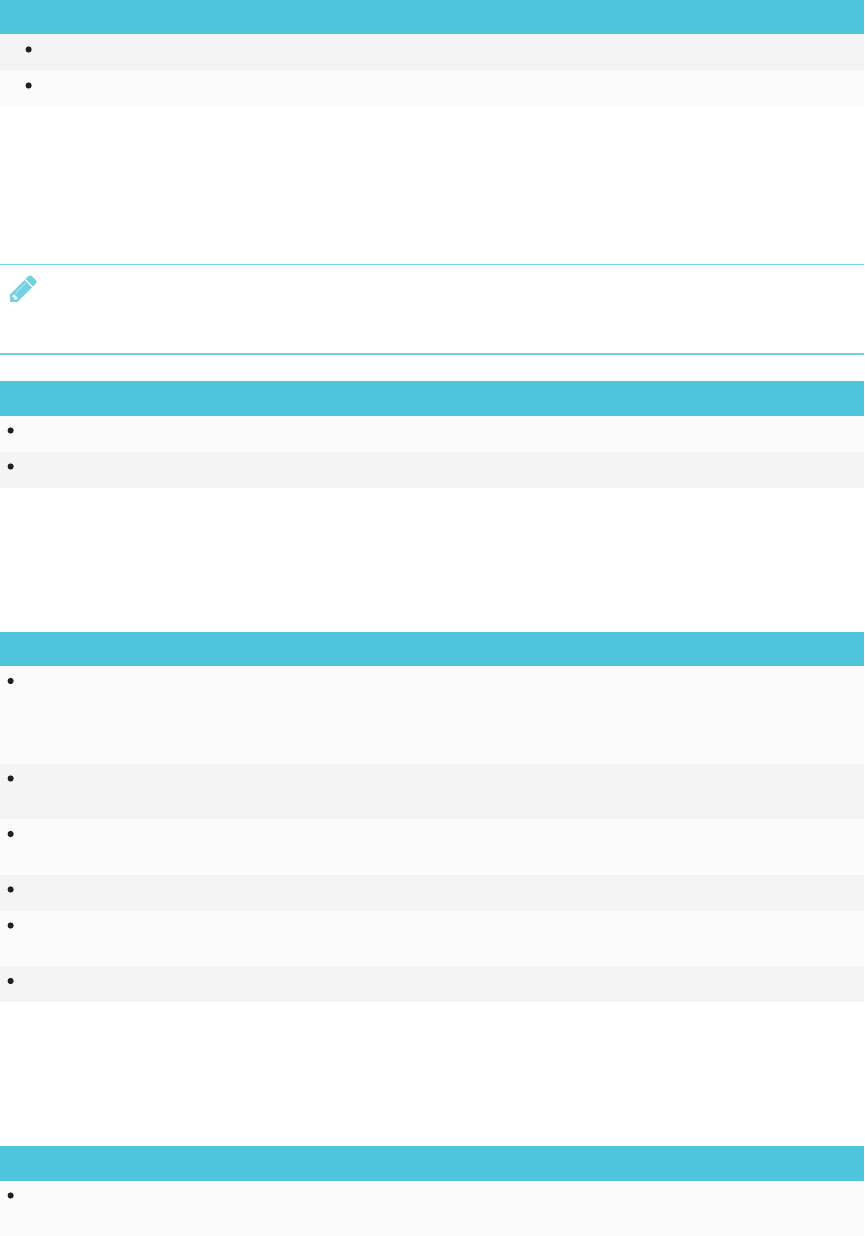
APPENDIX A
USING SETTINGS
67 smarttech.com/kb/171164
Option Values Function Notes
MACaddress [N/A] Shows the display’s MACaddress [N/A]
IPaddress [N/A] Shows the display’s IPaddress [N/A]
Ethernet
NOTE
Manual configuration isn’t available. The IPaddress is automatically configured via DHCP.
Option Values Function Notes
IP address [N/A] Shows the display’s IPaddress [N/A]
MACaddress [N/A] Shows the display’s MACaddress [N/A]
Date & time
Option Values Function Notes
Automatic date & time [N/A] Sets the display’s date and time
automatically
Configure the network to allow
Network Time Protocol (NTP)
requests to Internet time servers.
See page30.
Set date [N/A] Sets the display’s date Disable Automatic date & time to
set the date manually.
Set time [N/A] Sets the display’s time Disable Automatic date & time to
set the time manually.
Select time zone [N/A] Sets the display’s time zone [N/A]
Use 24-hour format [N/A] Shows the display’s time using the
24-hour clock
[N/A]
Choose date format [N/A] Sets the display’s date format [N/A]
Usage Data
Option Values Function Notes
Share Usage Data [N/A] Sends usage statistics and error
reports to SMART
[N/A]
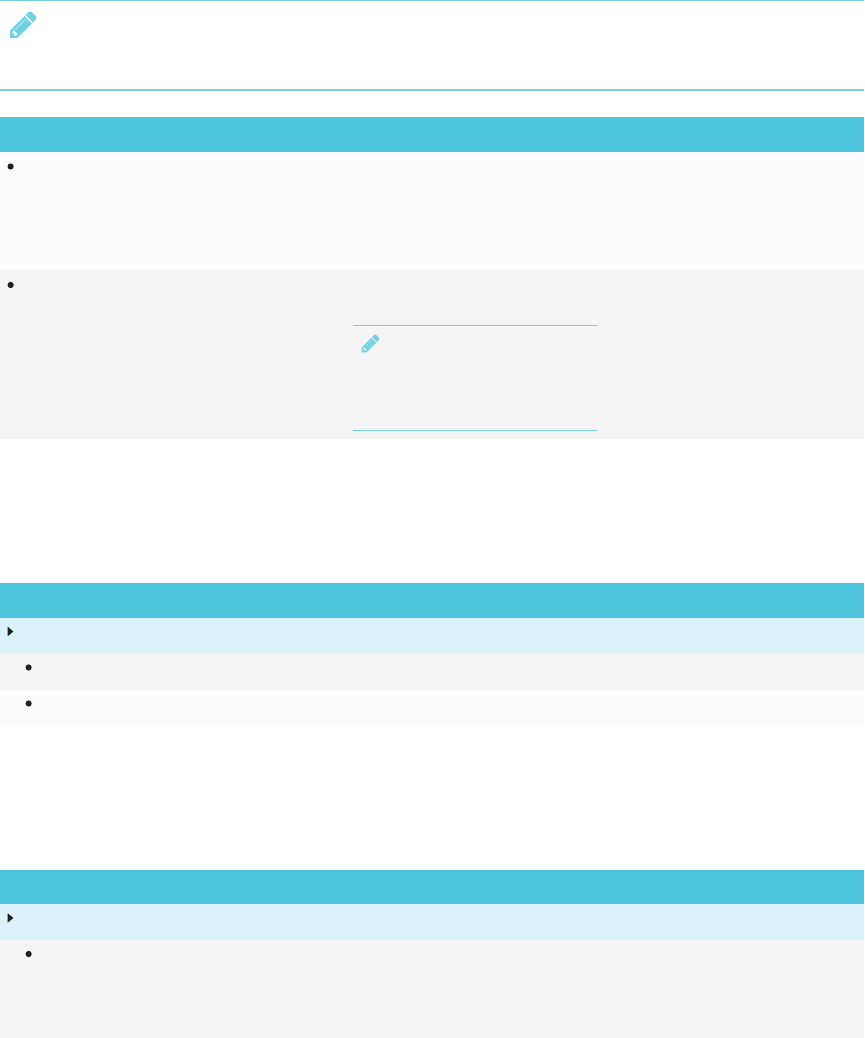
APPENDIX A
USING SETTINGS
68 smarttech.com/kb/171164
Auto Update
NOTE
To prevent automatic system software updates, block access to https://ws.kappboard.com.
Option Values Function Notes
Updates Channel Stable Channel
Beta Channel
Sets which system software
updates the display receives
When switching from the Beta
Channel to the Stable Channel, a
factory reset occurs. See page64
for more information about factory
reset.
Check for Updates Now [N/A] Checks for updates to the system
software
NOTE
The display must be connected
to the Internet to check for
system software updates.
If an update is available, the text
changes to Apply update now.
Display
Option Values Function Notes
Adjust Brightness and Contrast
Brightness 0–100 Sets the display’s brightness level [N/A]
Contrast 0–100 Sets the display’s contrast level [N/A]
Audio
Option Values Function Notes
Speakers
Built-in Speakers On
Off
Enables or disables the display’s
internal speakers
When analog speakers are
connected to the display, it
automatically disables the display’s
internal speakers.

APPENDIX A
USING SETTINGS
69 smarttech.com/kb/171164
Option Values Function Notes
Audio Properties
Balance 0–100 Sets the audio output from the
speakers
Drag the slider all the way to the left
to have all audio from the left
speaker. Drag the slider all the way
to the right to have all the audio
from the right speaker.
Bass 0–100 Sets the bass level [N/A]
Treble 0–100 Sets the treble level [N/A]
Launcher
Option Values Function Notes
Launcher [N/A] Select the apps available on the
launcher
See page38 for more information.
SMARTiQ Whiteboard
Option Values Function Notes
Whiteboard storage
Library On
Off
Enables or disables saving
whiteboard sessions
[N/A]
Save whiteboards in
library
For 1 week
For 1 Month
Indefinitely
Sets how long the whiteboard
sessions are saved
[N/A]
Mobile app
Saving Whiteboards On
Off
Enables or disables the Capture
function in the SMARTkapp app
If this is off, the QR code is not
visible. The SMARTkapp app is
unable to connect to the display
and your mobile device is unable to
save snapshots of the display in the
app.
Sharing Whiteboards On
Off
Enables or disables the Invite
function on the SMARTkapp app
If this is off, you’re unable to invite
people to your session.

Appendix B
73 smarttech.com/kb/171164
Appendix B: Remotely managing the display
Connecting a computer to the display 74
Connecting multiple displays 75
Configuring the computer’s serial interface settings 75
Power states 76
Commands and responses 76
Commandinventory 79
Resolving issues with remote management 81
You can connect a computer to the room control input on the display to remotely select video
inputs, turn the display on or off and get information about the display’s current settings, such as
contrast and power state.
NOTE
You can remotely manage only the display and not the iQ appliance.
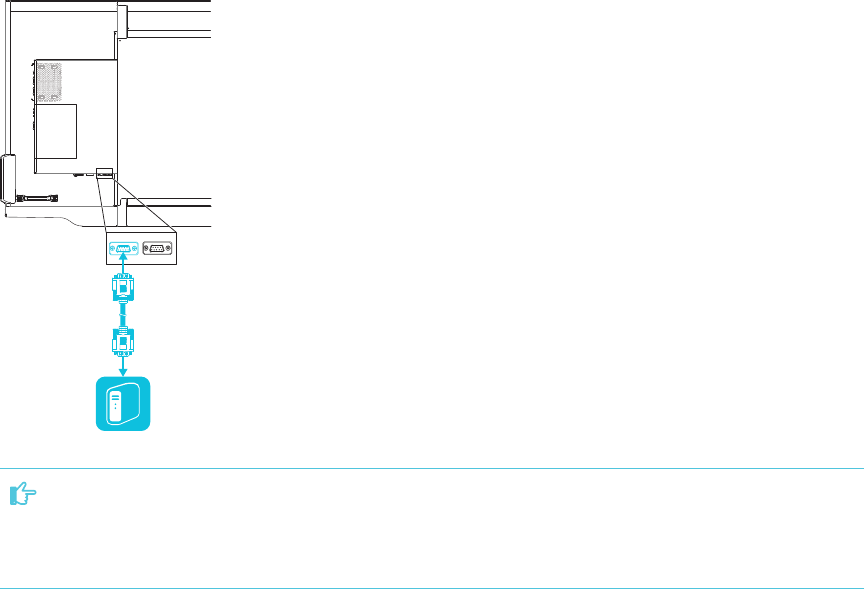
APPENDIX B
REMOTELY MANAGING THE DISPLAY
74 smarttech.com/kb/171164
Connecting a computer to the display
Connect an RS-232 cable from the computer’s serial output to the room control input on the
bottom of the display.
IMPORTANT
Use only a standard RS-232 cable. Do not use a null modem cable. Null modem cables typically
have ends of the same type.
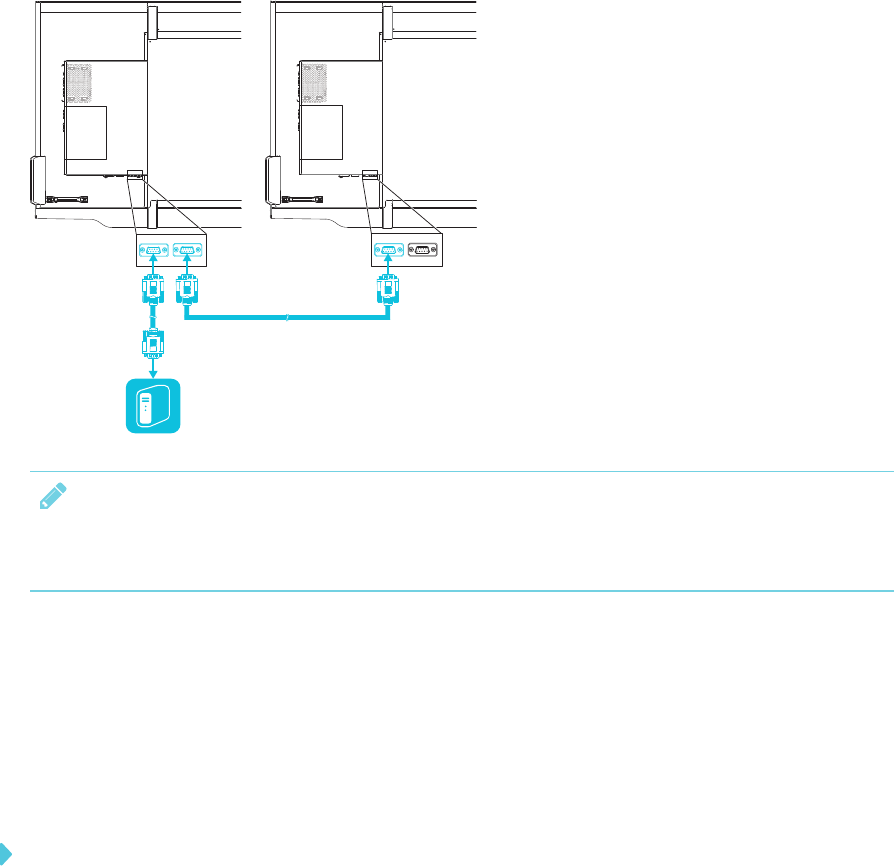
APPENDIX B
REMOTELY MANAGING THE DISPLAY
75 smarttech.com/kb/171164
Connecting multiple displays
You can connect up to ten displays to a room control system by connecting a RS-232 cable from
the computer’s serial output to the first display’s room control input and then connecting another
RS-232 cable from the first display’s room control output to the next display’s room control input:
NOTE
With the exception of the getinput,setinput and getfwver, all remote management
commands apply to all connected displays.
Configuring the computer’s serial interface
settings
Configure the computer’s serial interface before sending commands to the display.
To configure the computer’s serial interface
1. Turn on the display.
2. Turn on the computer, and then start the serial communications program or terminal emulation
program.
3. Activate local echo.

APPENDIX B
REMOTELY MANAGING THE DISPLAY
76 smarttech.com/kb/171164
4. Configure the serial interface settings using the following values, and then press ENTER.
Baud rate 19200
Data length 8
Parity bit None
Stop bit 1
A command prompt (>) appears on the following line, and the display can now accept
commands from the computer.
NOTE
If no message appears or an error message appears, the serial interface isn’t configured
correctly. Repeat steps 3 and 4.
Power states
The display has six power states:
Power state Description
ON The display is in normal operating mode.
READY The screen is off, but the display is ready to respond to user input.
STANDBY The screen is off, and the display is in a low power state.
POWERSAVE The screen is off, and the display is a very low power state.
UPDATEON The display is updating firmware. Do not turn off the display.
UPDATEREADY The display is updating firmware while the screen is off. Do not turn off the
display.
All commands are available when the display is on.
Commands and responses
To access display information or to adjust display settings using the room control system, type
commands after the command prompt (>), and then wait for the response from the display.
CORRECT
>get volume
volume=55

APPENDIX B
REMOTELY MANAGING THE DISPLAY
77 smarttech.com/kb/171164
If you type a command that the room control system doesn’t recognize, you will receive an invalid
command response.
In the example below, the user included an extra space in the volume command.
INCORRECT
>set vol ume=65
invalid cmd=set vol ume=65
NOTES
lUse ASCII formatted commands.
lCommands aren’t case-sensitive.
lReview each entry carefully before you press ENTER.
lDon’t send another command until you receive the response and the next command
prompt.
To identify the current value of a setting
Use a get command.
This example shows how to get the volume:
>get volume
volume=55
To assign a value to a setting
Use a set command.
This example sets the volume to 65:
>set volume=65
volume=65

APPENDIX B
REMOTELY MANAGING THE DISPLAY
78 smarttech.com/kb/171164
To increase or decrease the value of a setting
Use the set command to increase or decrease the value by a designated number.
This example increases the volume by 5:
>set volume+5
volume=70
This example decreases the volume by 15:
>set volume-15
volume=55
To identify or assign a value for a specific display
Start the command with [Display],@, where [Display] is the display you want to apply the
command to.
This example sets the input for the rightmost display to HDMI 2:
>A,@ set input=hdmi2
@,A input=hdmi2
NOTES
oThe rightmost display is labeled A, the next rightmost display is labeled B, and so on.
oYou can identify a specific display for only the getinput,setinput and getfwver
commands.

APPENDIX B
REMOTELY MANAGING THE DISPLAY
79 smarttech.com/kb/171164
Commandinventory
The following table presents the available remote management commands for the display:
No. of
displays
Get command Set command Response
Power state
[N/A] get powerstate set powerstate[Value]
Where [Value] is one of the
following:
l=on
l=ready
l=standby
l=powersave
NOTE
You can only change the power
state if the displays are currently
on.
powerstate=[Value]
Where [Value] is one of the
following:
lon
lready
lstandby
lpowersave
lupdateon
lupdateready
Input
One get input set input[Value]
Where [Value] is one of the
following:
l=hdmi1
l=hdmi2
l=dp1
l=vga1
l=ops1
input=[Value]
Where [Value] is one of the
following:
lhdmi1
lhdmi2
ldp1
lvga1
lops1
More than
one
[Display],@ get input
Where [Display] is the
display’s label (A,B, and so on).
[Display],@ set input[Value]
Where
l[Display] is the display’s label
(A,B, and so on).
l[Value] is one of the following:
o=hdmi1
o=hdmi2
o=dp1
o=vga1
o=ops1
@,[Display] input=[Value]
Where
l[Display] is the display’s
label (A,B, and so on).
l[Value] is one of the
following:
ohdmi1
ohdmi2
odp1
ovga1
oops1

APPENDIX B
REMOTELY MANAGING THE DISPLAY
80 smarttech.com/kb/171164
No. of
displays
Get command Set command Response
Brightness
[N/A] get brightness set brightness[Value]
Where [Value] is one of the
following:
l+[Value]
l-[Value]
l=[5–100]
brightness=[Value]
Where [Value] is a number
between 5 and 100
Freeze
[N/A] get videofreeze set videofreeze[Value]
Where [Value] is one of the
following:
l=on
l=off
videofreeze=[Value]
Where [Value] is one of the
following:
lon
loff
Volume
[N/A] get volume set volume[Value]
Where [Value] is one of the
following:
l+[Value]
l-[Value]
l=[0–100]
volume=[Value]
Where [Value] is a number
between 0 and 100
Mute
[N/A] get mute set mute[Value]
Where [Value] is one of the
following:
l=on
l=off
mute=[Value]
Where [Value] is one of the
following:
lon
loff
Firmware version
One get fwver [N/A] fwver=[Value]
Where [Value] is the firmware
version.
More than
one
[Display],@ get fwver
Where [Display] is the
display’s label (A,B, and so on).
[N/A] @,[Display] fwver=[Value]
Where
l[Display] is the display’s
label (A,B, and so on).
l[Value] is the firmware
version.
Serial number
[N/A] get serialnum [N/A] serialnum=[Value]
Where [Value] is the serial
numbers of connected displays.
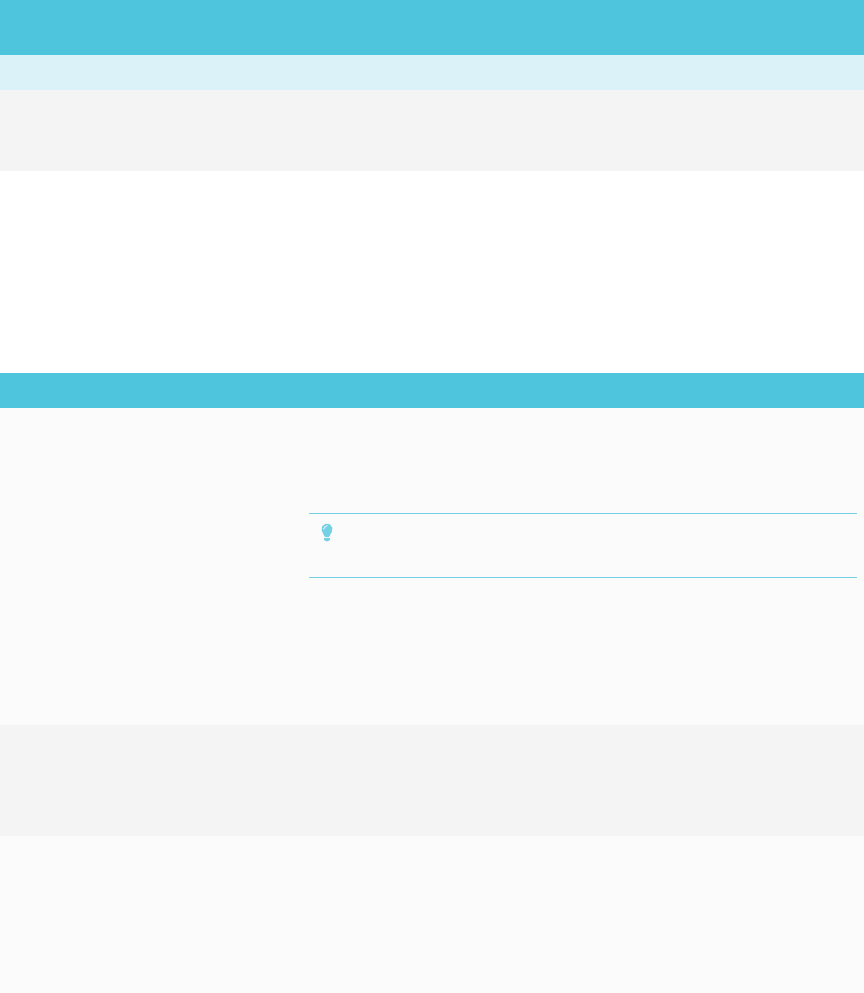
APPENDIX B
REMOTELY MANAGING THE DISPLAY
81 smarttech.com/kb/171164
No. of
displays
Get command Set command Response
Hardware version
[N/A] get hwversion [N/A] serialnum=[Value]
Where [Value] is the hardware
versions of connected displays.
Resolving issues with remote management
The following table presents common issues with remote management and explains how to
resolve them:
Issue Solutions
You can’t establish a connection
between the display and the
remote management system.
lConfigure the serial interface settings.
See Configuring the computer’s serial interface settings on page75.
lDon’t connect the display to the remote management system with null modem
cables.
TIP
Null modem cables usually have the same connectors on both ends.
lCheck the cable connections.
lDisconnect all cables from the display except the RS-232 cable. Reconnect the
cables one at a time to isolate the cable connection causing the issue.
lConnect a short cable from the display to a computer and then run a terminal
emulation program like PuTTY or TeraTerm. If the display responds to
commands, the issue is likely with the remote management system.
You can establish a connection
between the display and the
computer, but the display isn’t
accepting commands.
lBe aware that commands only work when the display is on.
See Commandinventory on page79.
lRestart the display.
See Turning the display off and back on on page43.
You can establish a connection
between the display and the
computer, but the display is only
accepting commands
intermediately or is ignoring some
commands.
lBe aware that commands only work when the display is on.
See Commandinventory on page79.
lMake sure the remote management system is not continuously polling for data.
For example, requesting power status every 0.5 seconds can cause issues.
lRestart the display.
See Turning the display off and back on on page43.

Appendix C
83 smarttech.com/kb/171164
Appendix C: Hardware environmental
compliance
SMARTTechnologies supports global efforts to ensure that electronic equipment is manufactured,
sold and disposed of in a safe and environmentally friendly manner.
Waste Electrical and Electronic Equipment (WEEE)
Electrical and electronic equipment contain substances that can be harmful to the
environment and to human health. The crossed-out wheeled bin symbol indicates that
products should be disposed of in the appropriate recycling stream and not as regular
waste.
Batteries
The pens contain rechargeable lithium batteries. Recycle or dispose of batteries properly.
More information
See smarttech.com/compliance for more information.
